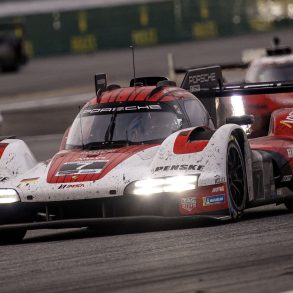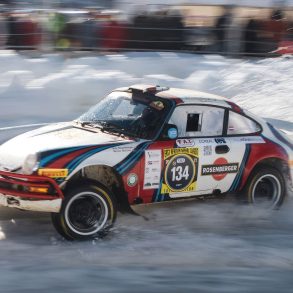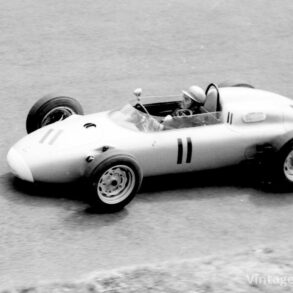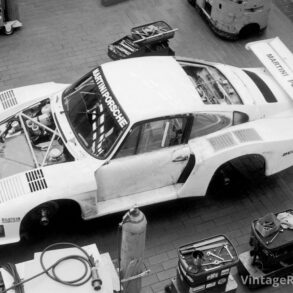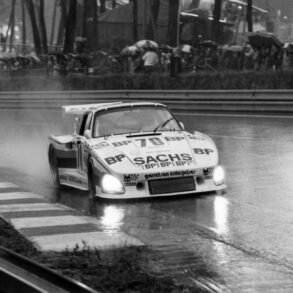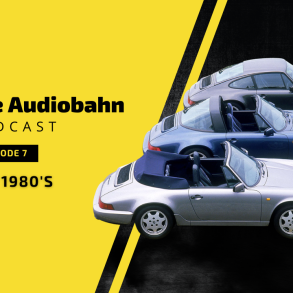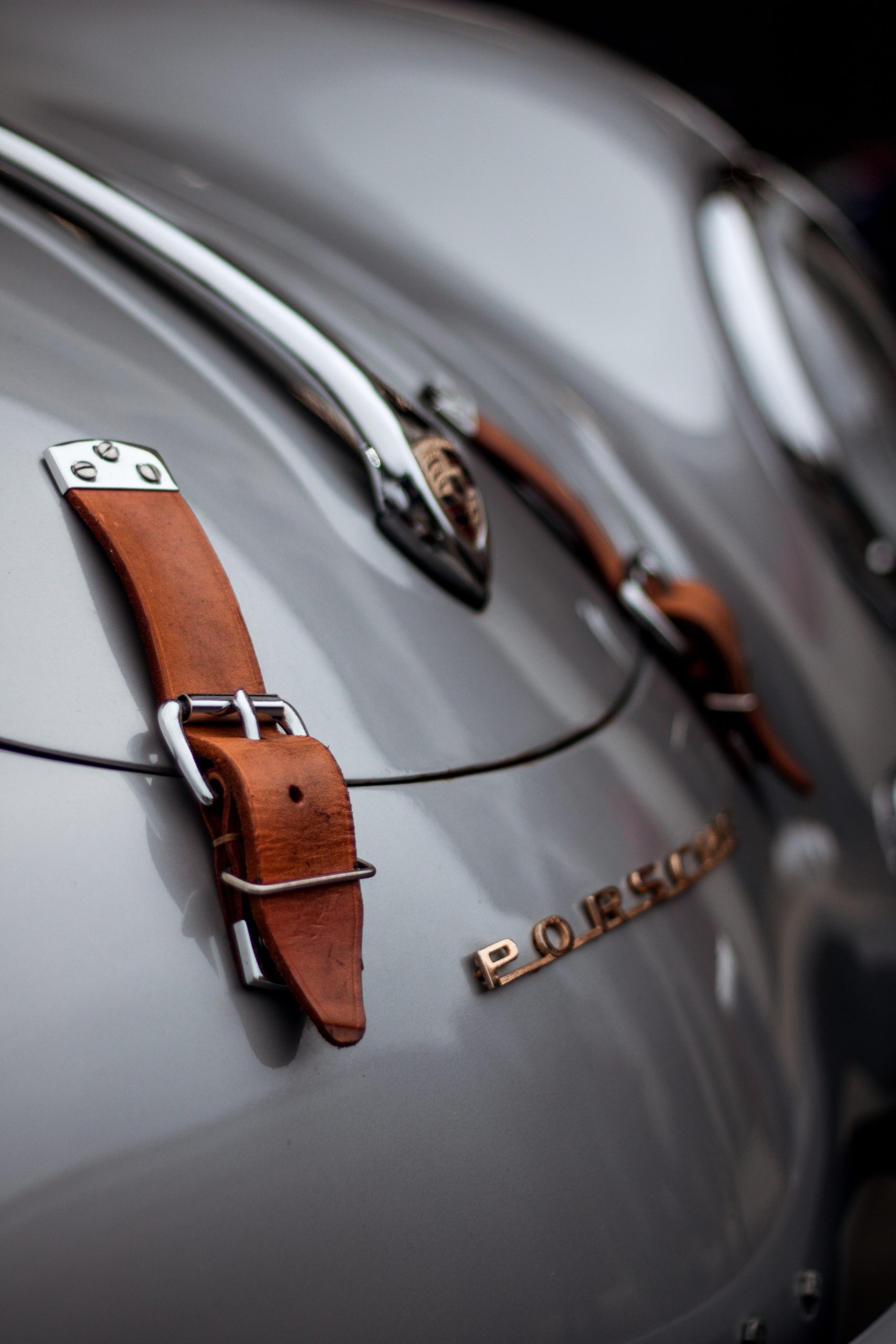Porsche at Le Mans – The Ultimate Guide to Every Year & Every Result
Circuit de la Sarthe is situated 130 miles/209 km west of Paris beside the city of Le Mans in the Sarthe county. The circuit is mostly a combination of country roads closed for the race, but also parts of permanent Bugatti circuit. Porsche is the most successful automobile manufacturer at Le Mans with 16 outright victories plus one as a Dauer plus 2 with Porsche engine in TWR chassis. Until now, there have been 14 track variations and Porsche has competed on the last 12 of them. 814 Porsches have started the twice-around-the-clock-race between 1951 and 2019.
The first 24 hour race was in 1923 and the track length was 17262 m. First change to track was made in 1929 an the new track length was 16340 m (-922 m). In 1932 the track length was decreased to 13492 m (-2848 m) which it more or less has kept ever since. New for the third variant of the Circuit de la Sarthe was the fast corner combination called the Esses leading into the Tertre Rouge right-hander just before the long Hunaudières straight.
1951 Le Mans – Porsche Finished 20th Overall
On initiative of Porsche’s importer in France, Auguste Veuillet, Porsche was the first German make to enter Le Mans 24 hour race after World War II. In 1951, two aluminium-bodied 1.1-litre 356’s were entered – #46 driven by Auguste Veuillet/Edmond Mouche and #47 driven by Rudolph Sauerwein/Robert Brunet. Unfortunately the #47 car crashed in practise and didn’t start the race. The #46 scored 20th overall and also took the class victory, although it is not that important as only three cars competed in the 1.1-litre class and only two finished. Half of the 60 starters didn’t finish the race. The cars that finished in front of the Porsche, had 2.0- to 5.4-litre engines and the ones behind the 356, were mostly the 750cc class cars.
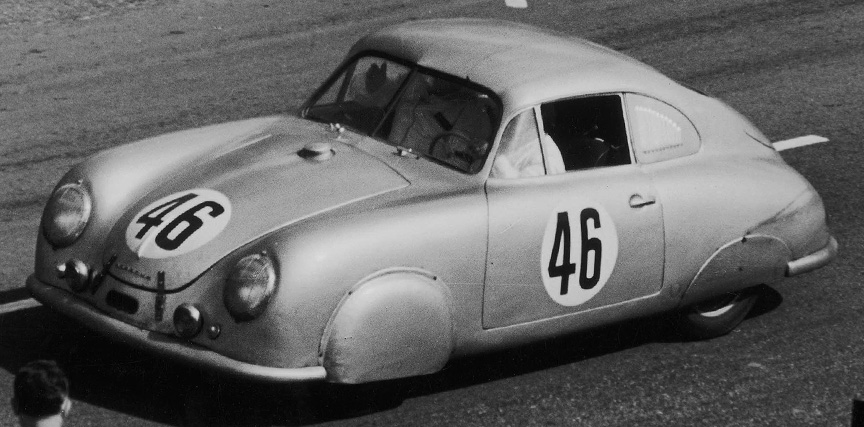
1952 Le Mans – Porsche Finished 11th Overall
Three 356 SLs started the race, two factory team cars and one private. The privately entered car of Auguste Lachaize/Eugéne Martin ended the race with an accident and the #51 car of Huschke von Hanstein/Petermax Müller had to retire because of a transmission problem. The car of Auguste Veuillet/Edmond Mouche was again the only Porsche to finish the race and this time on the 11th position overall (1st in 1.1-litre class).
The race is notable for the fact that Pierre Levegh (Pierre Eugène Alfred Bouillin) was the only driver for his Talbot-Lago T26 GS Spider. He managed to drive 23 hours in a row and was in the lead before he missed the gear and broke the engine. Levegh would die 3 years later at Le Mans in the most horrific disaster in the history of motorsports.
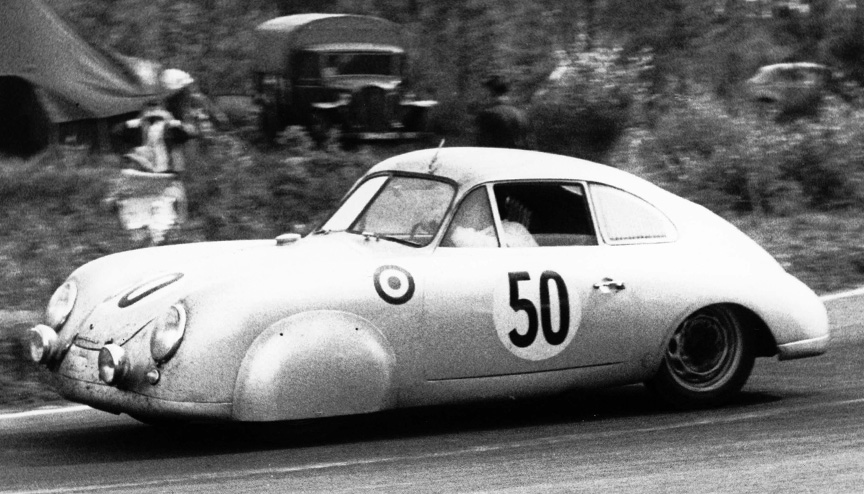
1953 Le Mans – Porsche Finished 15th & 16th
Porsche entered two 550 Coupés and one 356. One 356 was also entered privately. Both the 356s had to retire due to engine problems while the 550s scored 15th and 16th, also taking 1-2 in 1.5-litre class. The #45 car of Richard von Frankenberg/Paul Frère was faster than the #44 driven by Helmut Glöckler/Hans Herrmann. The highlight of the race are the Jaguars that feature disc brakes and won the race.
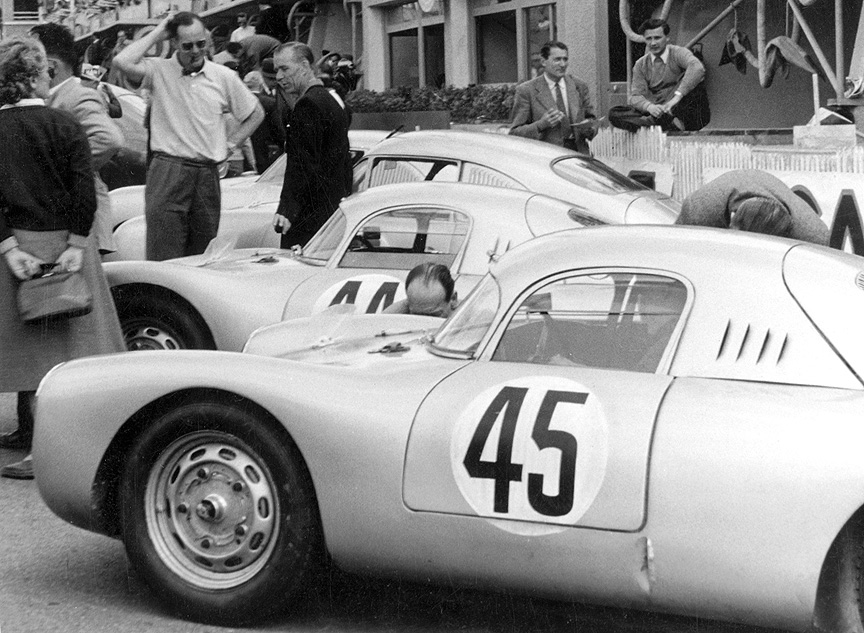
1954 Le Mans – Porsche Finished 12th & 14th
Porsche factory team fielded four 550 Spyders, three 1.5-litre and one 1.1-litre. The engines were the new type designed by Ernst Fuhrmann, originally 1.5-litre, but also the 1.1-litre version was made from the 1.5-litre (yes, they took the bigger engine and made it smaller for the 1.1-litre class). Two 1.5-litre cars retired because of engine failures, while #39 of Johnny Claes/Pierre Stasse scored 12th overall and took 1.5-litre class victory and the #47 of Zora Arkus Duntov/Gonzague Olivier scored 14th overall and took 1.1-litre class victory.
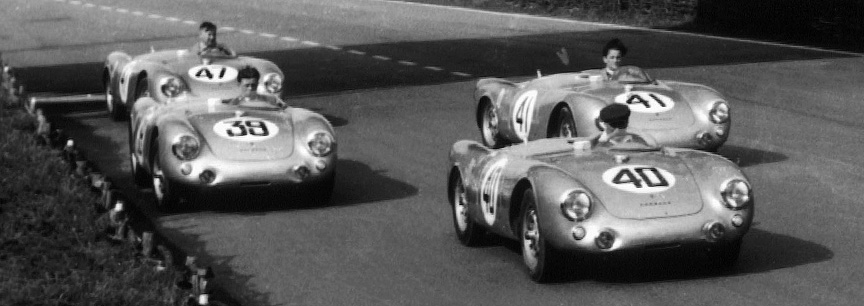

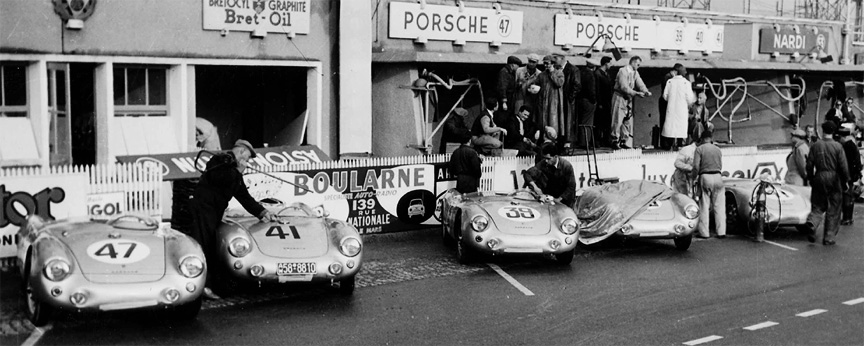
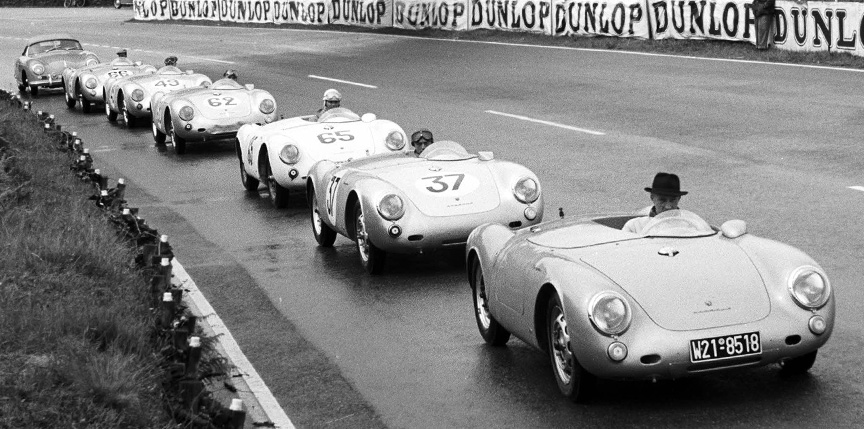
1955 Le Mans
Six 550 Spyders are fielded, three by Porsche (two 1.5 and one 1.1 L) and three by private teams (also two 1.5 and one 1.1 L).
A catastrophic accident happened in the race. Mike Hawthorn, approaching the grandstand and facing pit area, had just overtaken an Austin Healey when he suddenly decelerated for the pit stop. Hawthorn’s Jaguar was equipped with disc brakes and the Austin Healey driver lost control under heavy braking and was thrown in the path of a Mercedes that was closing at much higher speed. The Mercedes driven by Pierre Levegh hit the Austin Healey and became airborne. Mercedes was doing around 150 mph/240 kmh at the moment of the impact.
It disintegrated in the air, throwing body panels, mechanicals and fuel into the crowd on the grandstand, killing 80 and hurting another 120. Levegh was killed, too. The race was continued, official reason being that if the race would have been stopped, the roads would have been crowded and that would have made the ambulance cars impossible to arrive. If that was the reason, the race could have been stopped later, but it wasn’t. Mercedes finally decided to pull its cars out despite leading the race. The race was won by Mike Hawthorn/Ivor Bueb in #6 Jaguar D-type. While Hawthorn wasn’t guilty in the accident, his Jaguar’s superb disc brakes initiated it and it is therefore strange that he continued to race to the victory thanks to Mercedes pulling out of the race. The 1.5-litre Porsche Spyders finished 4-5-6 in this controversy race.

1956 Le Mans – Porsche Finished 5th & 13th
The pit area was completely redesigned after the disastrous accident in 1955. In order not to distract the drivers, pit boards were no longer permitted on the finish straight. This was now done after the Mulsanne hairpin. The altered track now had a length of 13461 m (-31 m). Porsche factory team fielded two 356s and two 550A RS Coupés. Two other 550s were entered privately. The only 550 that made it to the end of the 24 hour race, #25 550A RS Coupé of Richard von Frankenberg/Wolfgang von Trips, scored 5th overall which was the best real life result for Porsche yet as 4th overall in 1955 wasn’t in a typical race.
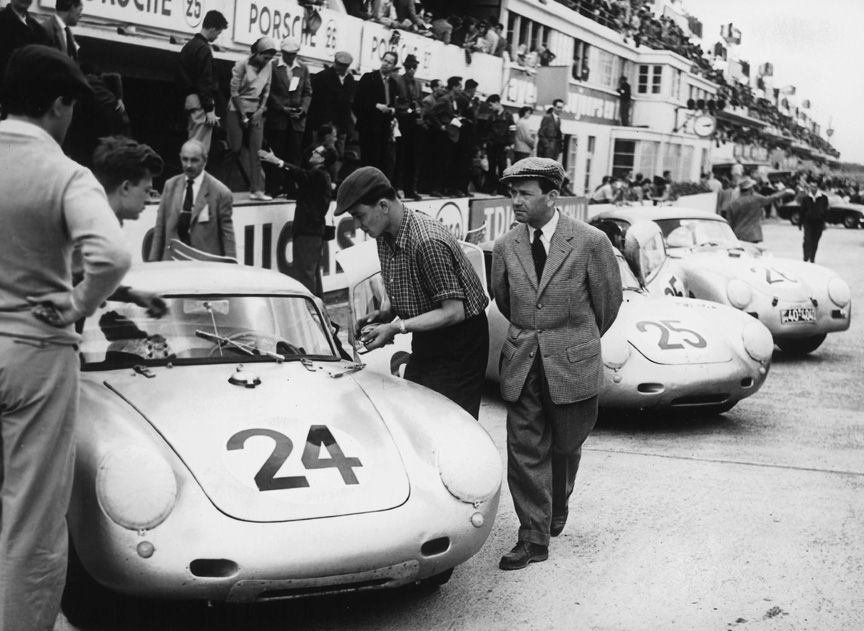

1957 Le Mans – Porsche Finished 8th
For 1957 Porsche fields its new 718 RSK together with two 550A RS. Private teams enter two more 550 and a 356. The only Porsche to make it to the finish is the privately entered 550A RS Spyder #35 of Ed Hugus/Carel Godin de Beaufort and they scored 8th overall (1st in 1.5-litre class).
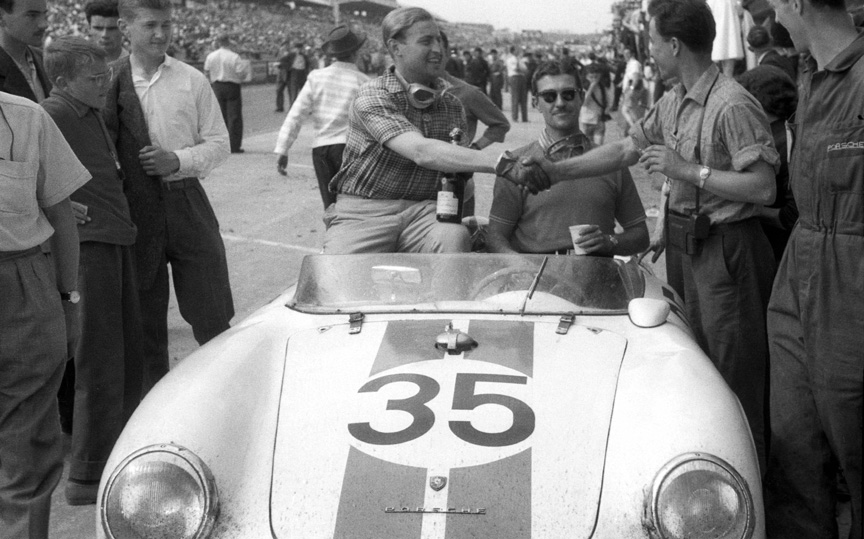
1958 Le Mans – Porsche Finished 3rd, 4th, 5th & 10th
Factory team fields three 718 RSK and private teams enter two 550A RS. The event is a real success for Porsche who celebrates 10 years of sports car production. First and second place are taken by 3-litre Ferrari and Aston Martin and then come the Porsches: on 3rd place 718 RSK 1.6 #29 of Jean Behra/Hans Herrmann (1st in 2-litre class), on 4th 718 RSK 1.5 #31 of Edgar Barth/Paul Frère (1st in 1.5-litre class) and on 5th 550A RS Spyder#32 of Carel Godin de Beaufort/Herbert Linge.
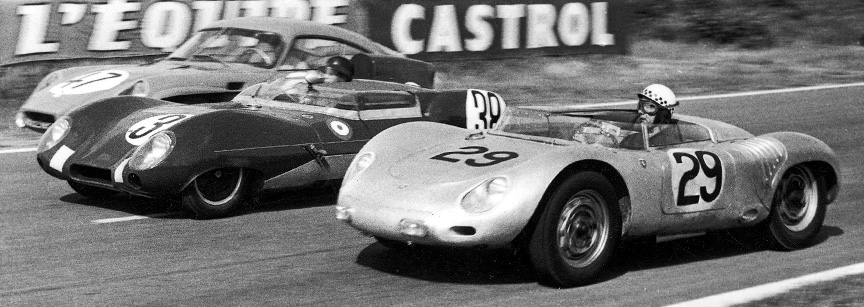
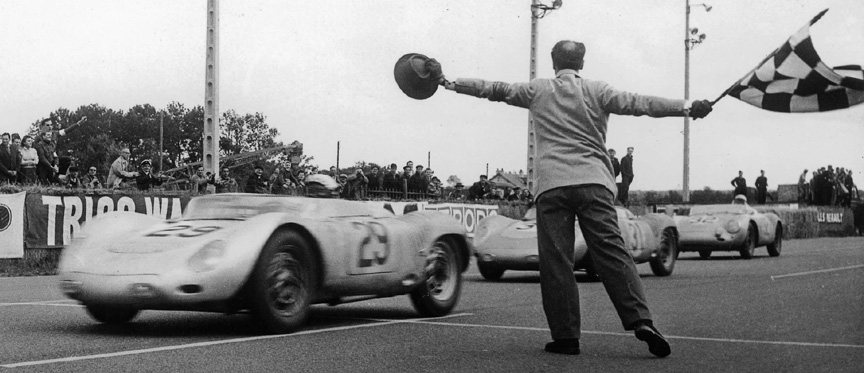
1959 Le Mans – Porsche (Complete Failure)
Following the success in 1958, the 1959 race was a complete failure for Porsche. Three 718 RSK were fielded by factory team, another two by privateers and one private 550A RS. All the cars retired due to technical problems (three with engine problems and three with transmission problems).
1960 Le Mans – Porsche Finished 10th & 11th
The evolution of the 718 RSK, the 718 RS 60 was created for 1960. Factory fielded three of them and two were entered by privateers. In cooperation with Abarth, Porsche entered one 356B Carrera Abarth GTL 1.6, which finished as the fastest Porsche on 10th position with 1.6-litre class victory in front of the 1.5-litre 718 while all 1.6-litre 718s retired due to engine problems.
1961 Le Mans – Porsche Finished 5th, 7th & 10th
Porsche fields three 718 and a 356 B Carrera Abarth GTL. The second 356 Abarth is entered by French importer Auguste Veuillet’s team. After 3-litre Ferraris and a Maserati, Porsche scores 5th and takes class victory with its 2-litre 718 Spyder #33 driven by Bob Holbert/Masten Gregory. The 718 Coupé #32 scores 7th driven by Hans Herrmann/Edgar Barth. The 356 Abarth scores 10th again as a year before, this time driven by Ben Pon in addition to Herbert Linge.
1962 Le Mans – Porsche Finished 7th & 12th
Only three Porsches compete this time, all being the 356B Carrera Abarth GTL’s, two Porsche factory team cars and one entered by Auguste Veuillet’s team. The best result for Porsche comes from #34 Edgar Barth/Hans Herrmann who finish 7th overall and take the 1.6-litre class victory.
1963 Le Mans – Porsche Finished 8th
Four Porsches were entered, all by Porsche factory team: the 718 W-RS Spyder and 718 GTR Coupé with 8-cylinder engines (2-litre) and two 356B GS Carrera 2 GT (4-cylinder 2-litre). As the best Porsche, the 718 W-RS #28 scored 8th driven by Edgar Barth/Herbert Linge. As there was no 2-litre class for prototypes, they competed in the 3-litre class and therefore didn’t get the class victory (all cars in front of them had 3-litre or larger engines).
An interesting entry in 1963 was the Rover BRM Turbine car driven by Graham Hill/Richie Ginther They finished 7th, but were not classified as there was no such class (they were an invited entry).
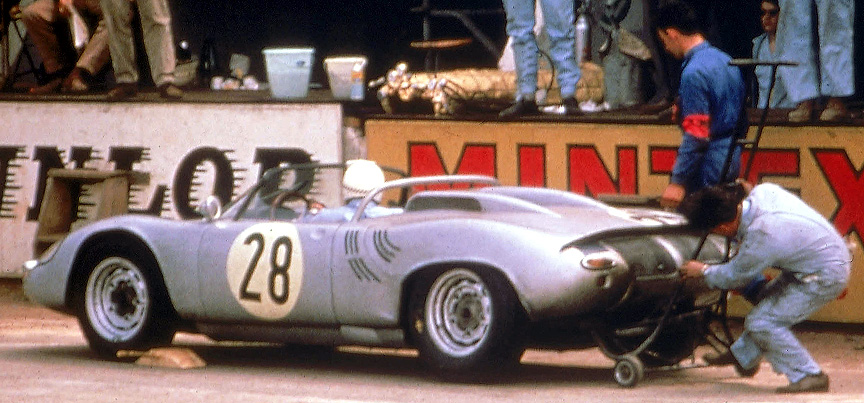
1964 Le Mans – Porsche Finished 7th, 8th, 10th, 11th & 12th
Eight new 904’s are signed up in total, three by factory team including two 8-cylinder cars (the only ones ever to be built). Both the 4- and 8-cylinder cars have 2-litre engines. One 4-cylinder is crashed already in the practise. The race takes out both the 8-cylinder cars with similar teething problems. The best result for Porsche is 7th position 904 #34 of Auguste Veuillet’s team driven by Robert Buchet/Guy Ligier. They were beaten only by 3-4-litre Ferraris and a 4.7-litre Shelby Cobra. Naturally the 2-litre class victory was Porsche’s.
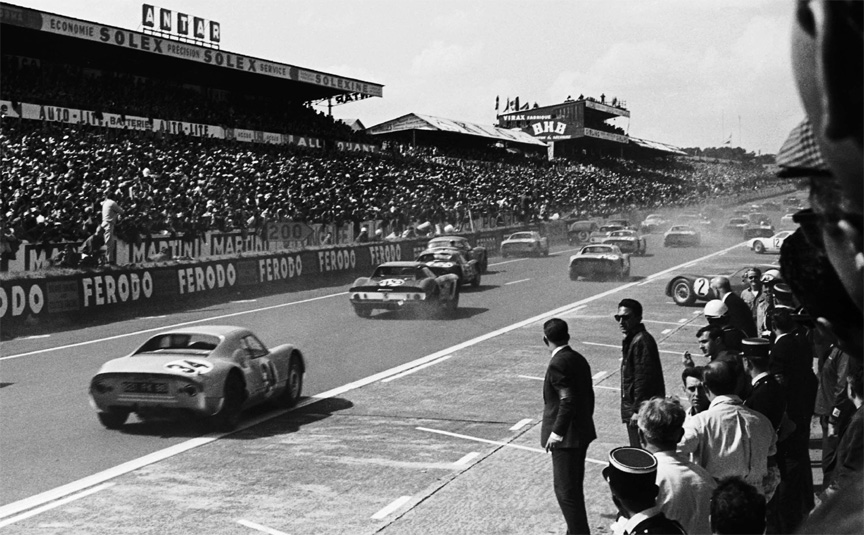
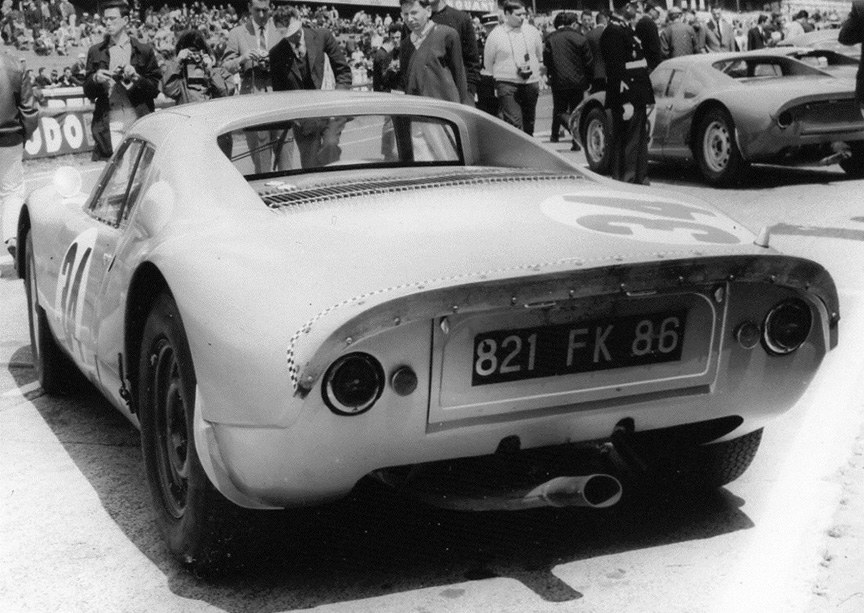
1965 Le Mans – Porsche Finished 4th & 5th
Again eight 904 are fielded including the same two 8-cylinder cars. One of the 8-cylinder cars is not entering the competition and the second one retires again. This year the factory team had fielded also two 6-cylinder 904s in addition to the 8-cylinder and a 4-cylinder (all 2-litre). One of the 6-cylinder cars has an engine failure, while the other finishes 4th driven by Herbert Linge/Peter Nöcker. They also take the victory in the 2-litre prototype class. They are followed by the factory team’s 4-cylinder car driven by Gerhard Koch/Anton Fischhaber (5th overall and 2-litre GT-class victory).
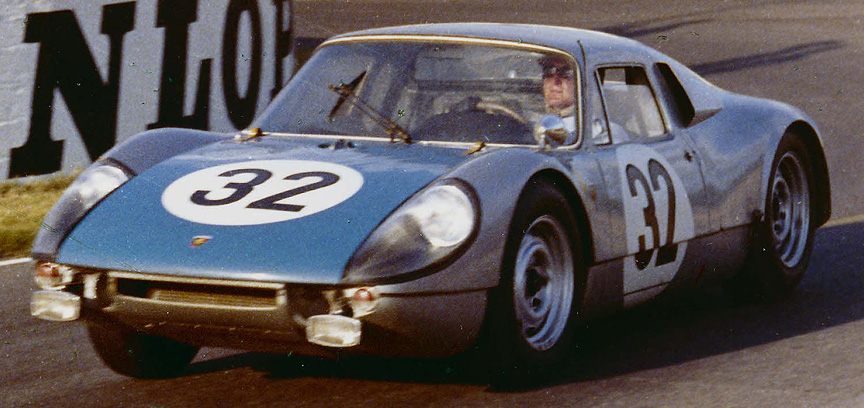
1966 Le Mans – Porsche Finished 4th, 5th, 6th, 7th & 14th
The Porsche 906 was the first Porsche racing car project where Ferdinand Piëch’s ideas could be implemented. The long tail version was created specially for the long straight part of the Le Mans track. Porsche enters six 6-cylinder 906 – five directly by factory team and one by Auguste Veuillet’s team. The first 911 is also privately entered. In addition to Porsche, the race saw numerous new and very cool cars. The result of the race is fantastic for Porsche – four 2-litre 906s place 4-5-6-7 after three 7-litre GT40s. The GT40 drivers were informed in the last pit stop to finish close to each other for a good publicity photo and for some reason the 2nd position car #2 driven by Bruce McLaren drove past the #1 of Ken Miles just before the finish line and made himself a winner.
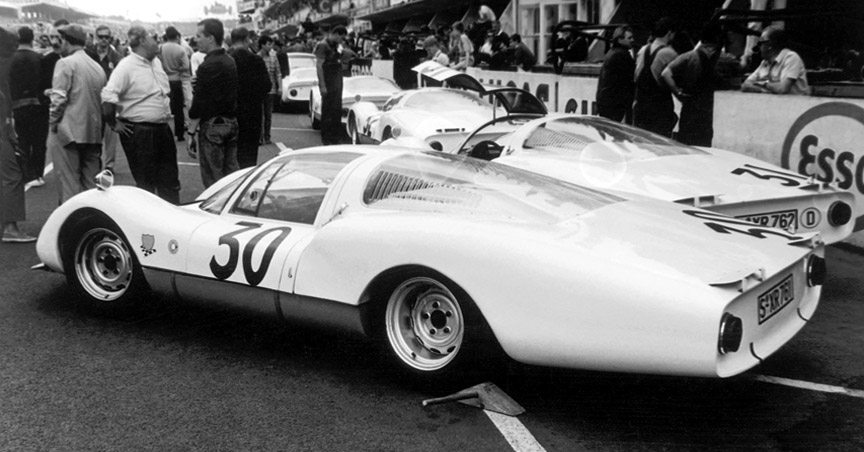
1967 Le Mans – Porsche Finished 5th, 6th, 7th, 8th & 14th
Ferdinand Piëch’s era had begun, the era when approximately every second month a new racing car or a modification was created. For Le Mans, the new 907 is ready. Two cars are entered along with two 910 plus a single 906 by factory team and another privately owned. In addition, four 911s are entered privately, making a total of 10 Porsches which is a new record. All ten Porsches have 2-litre 6-cylinder engines. As suggested by Ferdinand Piëch, the position of the driver for the 907 was moved from the traditional left (as in German road cars) to the right as this gives advantages on the predominant clockwise race tracks. The event was again success for Porsche – the 2-litre Porsches scored 5-6-7-8 after the 7-litre GT40s and 4-litre Ferraris. The fastest Porsche is 907 LH #41 of Jo Siffert/Hans Herrmann and they naturally took the 2-litre class victory.
Interesting story from the race – the leading GT40 of Dan Gurney was followed by faster Ferrari 330 P4 of Mike Parkes who had spent more time in pits and was laps behind. It was night and Parkes flashed lights in Gurney’s mirrors. Finally Gurney, not just let him pass, but completely stopped his car. Parkes stopped, too, and then passed him and continued the race. The Dan Gurney/A. J. Foyt team would win the race and at the victory stand, Gurney would shook the champagne bottle to spray everyone nearby – an obnoxious practice not to be lost during the following decades.
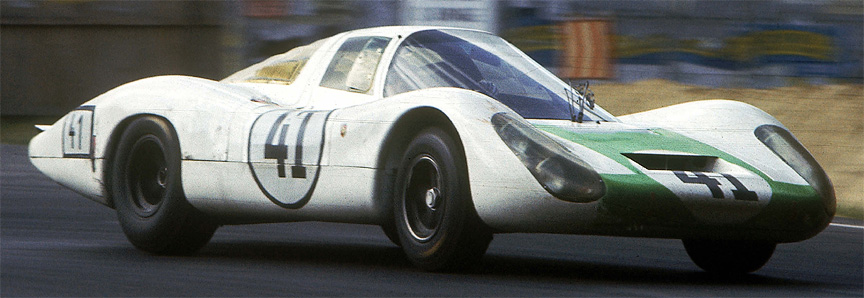
1968 Le Mans – Porsche Finished 2nd, 3rd & 12th
New to the track is the Ford chicane just before the finish straight. The intention is to reduce the speed between the grandstands and the pitlane. New track length is 13469 m (+8 m).
Porsche has finally produced a bigger engine – the 908 has a 3-litre flat-8. In addition to the four 908 LH coupés entered by the factory team, privateers entered three 907s, a 906, a 910 and four 911s. The 908 LH #31 of Jo Siffert/Hans Herrmann starts from the pole position as the fastest qualifier followed by the 908 LH #33 of Rolf Stommelen/Jochen Neerpasch and 908 LH #32 of Gerhard Mitter/Vic Elford. Technical problems force three out of four 908s to quit and the only surviving 908 #33 finishes third. An absolutely superb achievement indeed, if not to consider that the second place was achieved by 2.2-litre privately entered 907 of Squadra Tartaruga driven by Rico Steinemann/Dieter Spoerry.
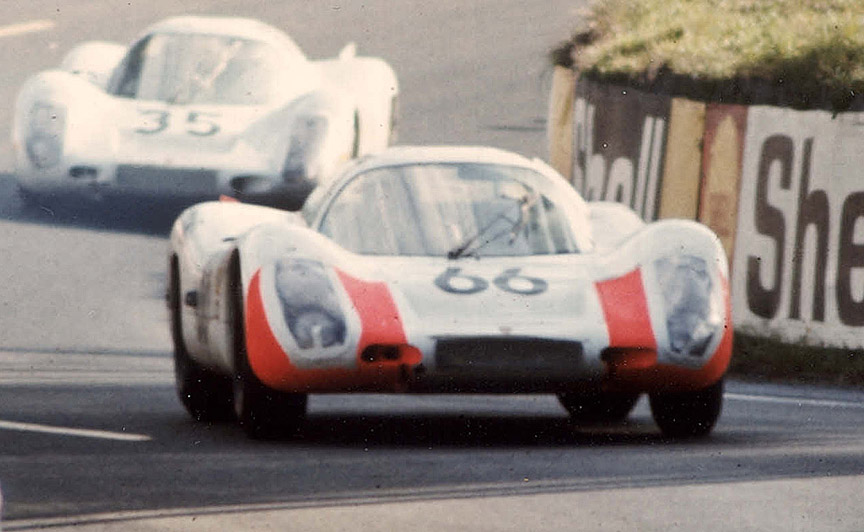
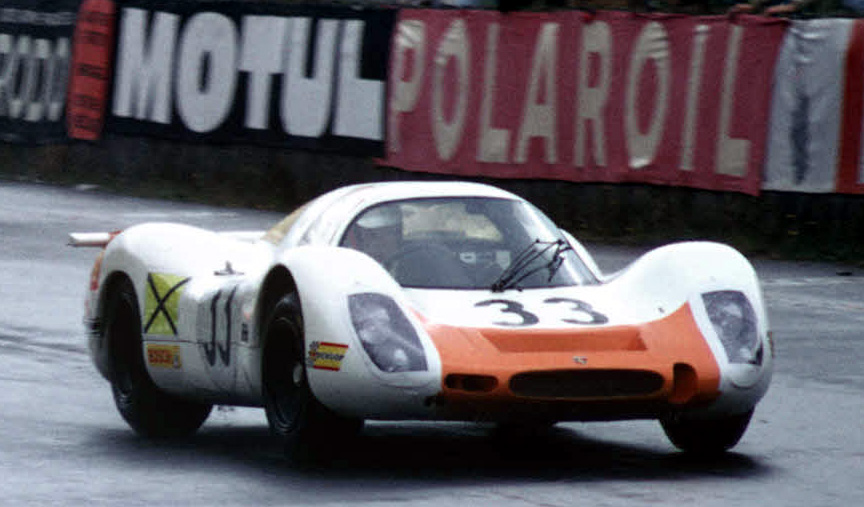
1969 Le Mans – Porsche Finished 2nd, 9th, 10th, 11th, 13th & 14th
For safety, the metal crash barriers were installed at the Mulsanne straight.
This is the first year Porsche wants to take overall victory and Ferdinand Piëch’s team has built a 4.5-litre flat-12 model called the 917. They produced 25 cars which was the minimum requirement for the 5-litre sportscar class. Factory team fielded three 917s (one of them was used only in practise) and three 908s. Private teams entered one more 917 (new Porsche racing car in the hands of private team on the first season – Porsche really needed money!), a 908, two 910s and seven 911s. In total 16 Porsches started the race. In qualification and in the race 917 sets the fastest laps.
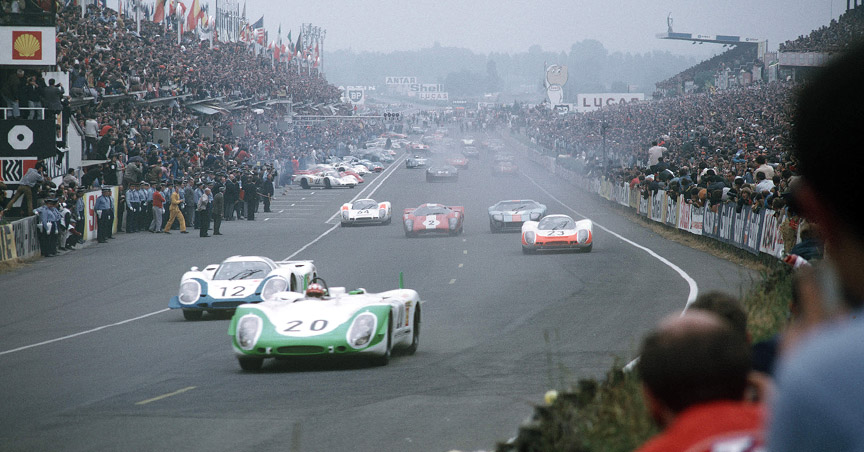
1969 June 14 Le Mans 24H start: #20 908/02 LH Flunder Spyder of Jo Siffert/Brian Redman (retired due to the gearbox), #12 917 of Vic Elford/Richard Attwood (they set the fastest lap during the race, but had to retire from the leading position because of the clutch failure), #23 908/01 LH of Udo Schütz/Gerhard Mitter (accident in the race), #64 908/01 LH of Hans Herrmann/Gérard Larrousse (finished 2nd), #22 908/01 LH of Rudi Lins/Willi Kauhsen (lost the gearbox)© Porsche
The race had a traditional Le Mans-style start where the drivers had to run across the race track, enter the cars, start the engines, fasten the seat belts and drive away. In reality seat belt fastening was done during the first lap while driving at full throttle and sometimes the belts were left unfastened. At this race Jacky Ickx protested this start style by walking, not running, to his car. With the LM-style start there wasn’t time to make sure the doors were safely closed and the introduction of the safety belts didn’t work at all with this type of start. Fatality happened on the first lap of the race. John Woolfe crashed his privately entered 917 on the first lap and was thrown out of the car. The fuel tank from his car landed in front of the oncoming Ferrari 312P of Chris Amon and exploded in contact. Fortunately Amon survived. The race was stopped, but was then restarted after 2 hours.
The 3-litre 908s were not the favourites against the large engined cars and so the 35 minute pit stop of the #64 car due to the faulty wheel bearing didn’t sound so dramatic as it would after the race. With less than four hours to the checkered flag, the 917 LH #12 is six laps in the lead, but loses the clutch and is out. The 917 LH #14 of Rolf Stommelen/Kurt Ahrens Jr. retired already earlier (oil leak). After all the three 917s were out, the race had unbelievable culmination – the #64 908 team (Hans Herrmann/Gerard Larrousse) wanted to beat the 4.9-litre GT40 #6 (Jacky Ickx/Jackie Oliver) to win the race!
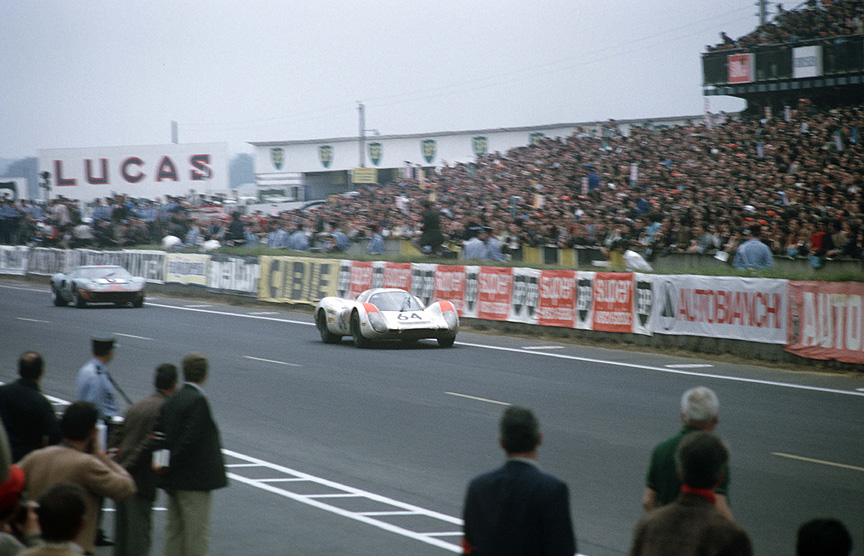
Herrmann is hesitant to use Porsche’s superior braking performance because the brake pad warning light is on. The #64 908 and the #6 GT40 consistently swap the lead during the three last hours of the race. The tension is so high, that a Porsche mechanic even used force on a photographer at the pitlane. Team boss Rico Steinemann said to the interviewer “I will never forget this motor race, whether we gonna win or lose it”.
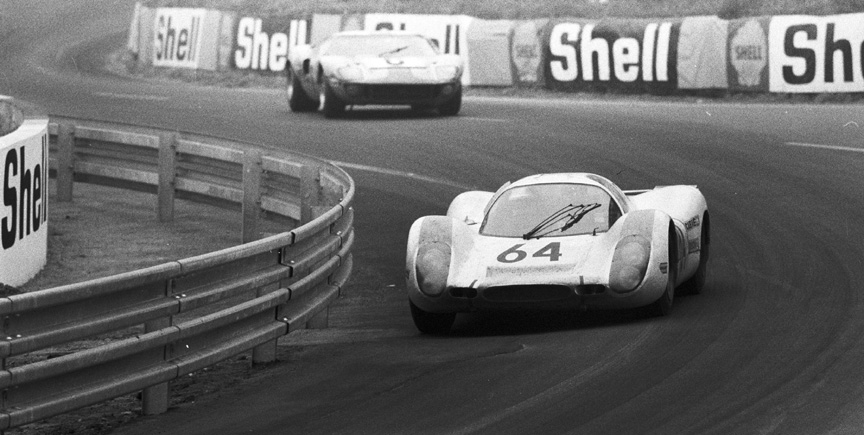
The lead was exchanged at least 10 times, but Ickx took the victory – the man, who started from the last position as a protest. The #64 Porsche lost only by around 30 meters – imagine losing 30 meters on a 4997880 meter distance! Ironically it turned out that the brake pad warning lamp system was faulty and the brakes were okay. By the way, Ickx drove exactly the same car – chassis 1075 – that already won the 1968 Le Mans. Ickx’s protest and the fatal accident with an unfastened driver finally put end to the traditional Le Mans start. By the way, Ickx drove home in a 911 and crashed it in a road accident.
1970 Le Mans – Porsche Finished 1st, 2nd, 3rd, 6th & 7th
More armco was installed around the track for safety reasons. The traditional Le Mans start was discontinued and the drivers had to sit in their cars, while the cars were still parked diagonally in front of the pits. Now there was the new problem – all the cars started at the same time causing a congestion. By 1970 Porsches were so famous racing cars that majority of privateers used Porsches. This meant that the starting grid of the 1970 Le Mans 24H saw 24 Porsches and 27 other cars. What can be better for marketing – now everybody wanted a Porsche.
One and half hours to the race it started raining. Soon after there was an incident with four Ferrari 512 – three of them involved in a crash which eliminated them and the engine in the fourth was ruined with unintended over-revving during this close escape. At that point already seven of top ten qualifiers were out of the race. The rain got heavier and Jacky Ickx was driving the last surviving factory entered Ferrari in the night from 6th place to the second when he crashed killing a marshal. By dawn the weather turned from rain to storm. Despite the 4.9 litre 917 LH driven by Vic Elford/Kurt Ahrens Jr. was the fastest car in qualification and started from the pole position, in the morning they had to retire due to engine failure. The race was won by Porsche Salzburg entered 917 K #23 driven by Richard Attwood/Hans Hermann. They were followed by two cars from Martini Racing, the second place went to 917 LH #3 of Gérard Larrousse/Willy Kauhsen and third to 908/01 LH Spyder #27 of Rudi Lins/Helmut Marko. Because of the awful weather conditions only 16 cars finished. As many of them were too many laps behind, only seven cars were finally classified. Porsche had won all the four classes that had finishers: 5-litre sports car class with the 917, 3-litre prototype class with the 908, 2-litre GT class with the 914 and finally the 2.5-litre GT class with the 911 S/T 2.3. Yes, in this order – the 914 was 6th and 911 7th overall. The 911 was co-driven by Erwin Kremer, a man who would found the famous Kremer Porsche racing team and would produce its own versions of Porsche racing cars.
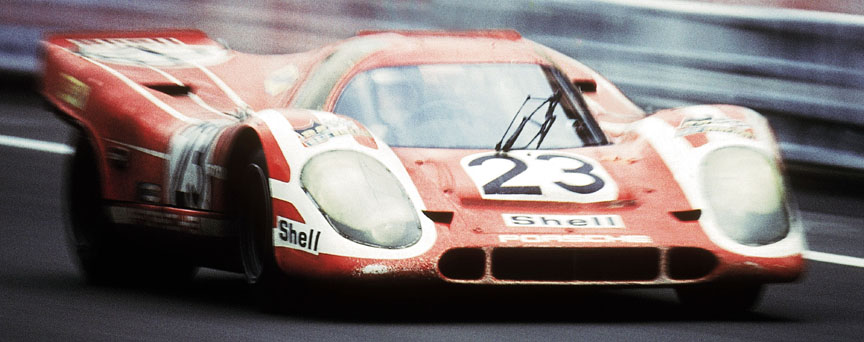

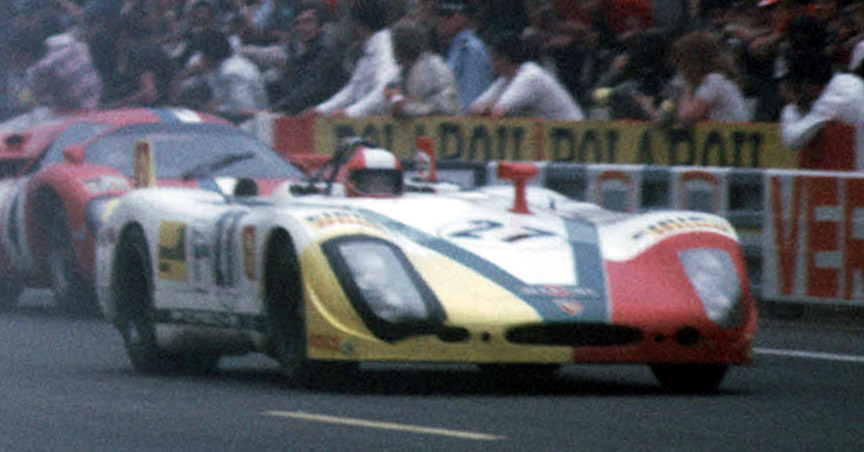
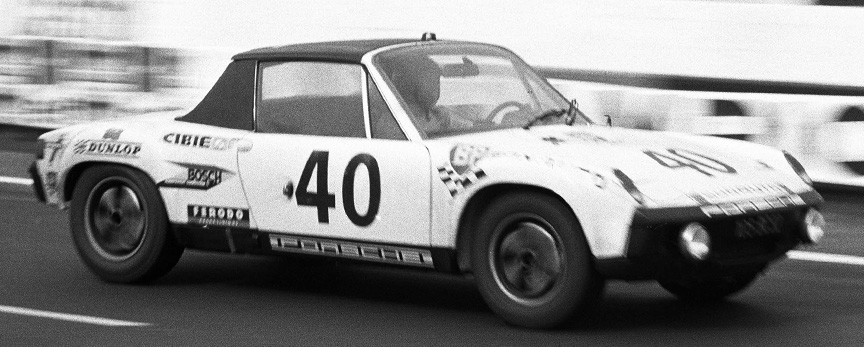
There was a 908/01 Spyder in the race that was equipped with three cameras to record footage for the Le Mans fiction movie of Steve McQueen. The 908 was McQueen’s personal racing car, but was not driven at Le Mans by McQueen as the other film producers didn’t allow McQueen to risk his health. Some say, McQueen secretly drove a stint.
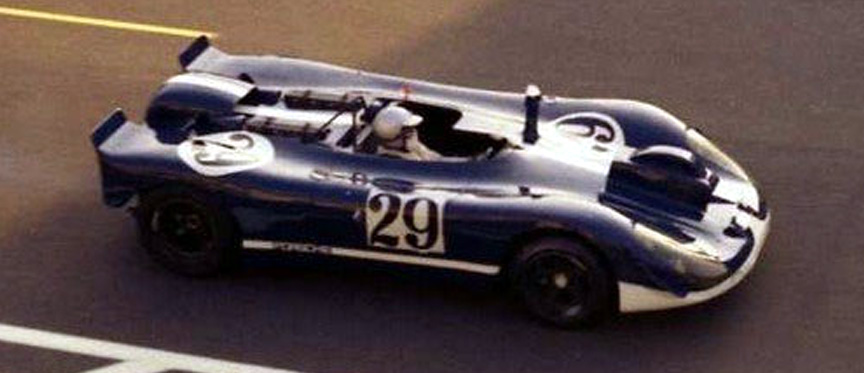
Solar Productions’ 908 with one camera in front and two at the rear above the transmission© unknown (please inform us if you know)
1971 Le Mans – Porsche Finished 1st, 2nd, 6th, 7th, 8th, 9th, 10th, 11th, 12th & 13th
The simultaneous start from the pits didn’t work well last year and a safer type of start was implemented, the rolling start. Porsche was for the 20th time at the event and Ferry Porsche was the man to drop the start flag.
The 1971 race was more like a Porsche Cup than a Le Mans race – 33 cars out of the 48 starters were Porsches. The 1971 was the year of records. During the pre-test, Jackie Oliver turned a lap in 3:13.6 with a 917 LH averaging 250.457 km/h (155 mph). Almost as fast was Pedro Rodriguez’s 917 LH in qualifying with 3:13.9 and average speed of 250.069 km/h. Only in 1985 would Hans-Joachim Stuck manage to smash the 250 km/h average speed barrier again. The longtail 917 LH was capable of doing 240 mph/386 kph on the main straight. In the race, Jackie Oliver turned the fastest lap in 3:18.4 or 244.387 kph (151 mph) record average speed that would only be exceeded 37 years later in 2008. Unfortunately all three 917 LHs that were the fastest cars in qualification, had to retire because of engine problems. It was the second year in a row that the special long tail Le Mans versions of the 917 were the fastest cars in qualification, but their 4.9-litre engines couldn’t last the 24 hour race. It’s a pity 1971 would be the last time the large-engined 917s are allowed to race in Europe. On their charge to victory, Marko/Van Lennep cover record 5335.313 km (3315 miles) averaging 222.304 kph (138 mph) with their short-tail 917 K-71. As the engineers didn’t want to make the drivers nervous, they were told only after the race that their 917 had a new superlight magnesium tubular frame. In the finish 13 cars are classified including 10 Porsches and 3 Ferraris. The speed and distance records stand 38 years, until 2009.
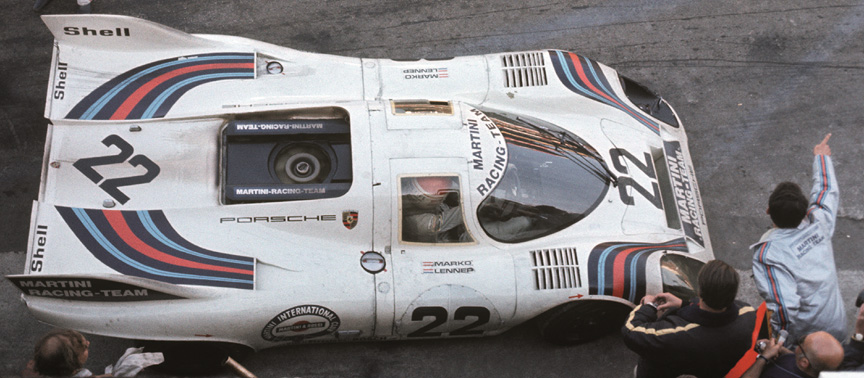
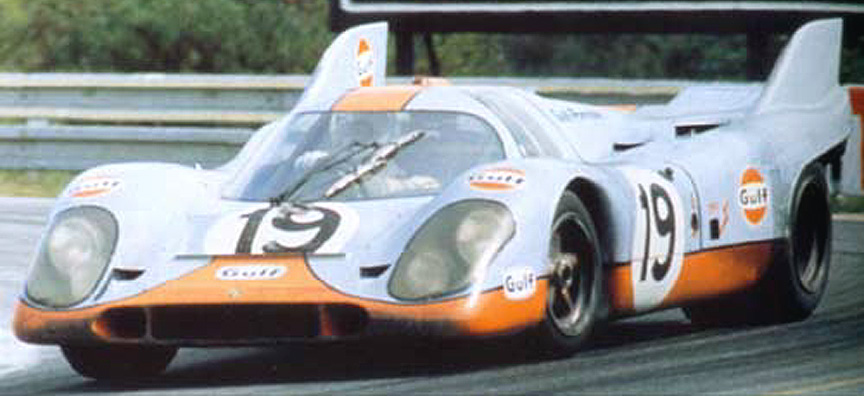
1972 Le Mans – Porsche Finished 3rd, 13th & 18th
The section between the Arnage right-hander and the Ford corner is revamped and the very fast Porsche curves are created. The Ford corner gets a second chicane. The track length is now 13640 m (+171 m)
The 5-litre prototype class was discontinued for 1972 season in Europe, rendering the 917s unusable. So, the few years old 3-litre 908s were digged out and seven cars were entered by private teams. Famous racing driver Jo Bonnier kills himself driving a Lola. His teammates were Porsche drivers Gijs van Lennep (last year’s winner) and Gerard Larrousse (2nd place 1969 and 1970). The best Porsche scores third – the 908/01 LH-68 of Siffert ATE Racing Team driven by Reinhold Joest/Michel Weber/Mario Casoni.
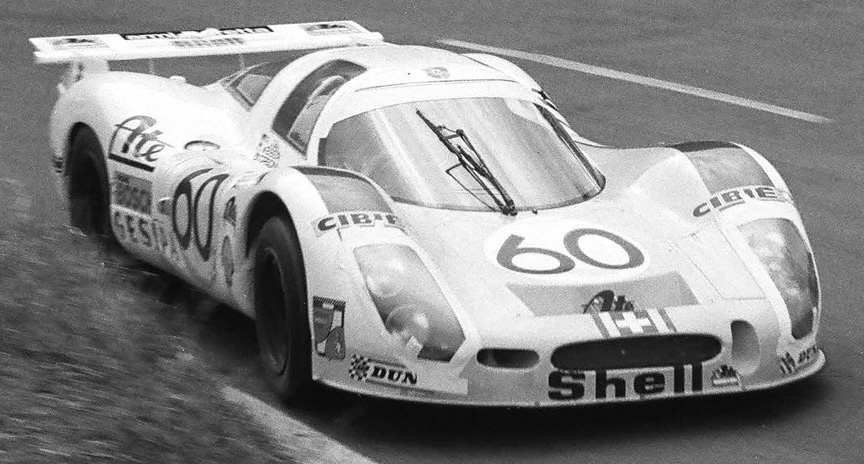
1973 Le Mans – Porsche Finished 4th, 5th, 7th, 8th, 10th, 14th, 16th, 17th & 21st
Martini Racing enters two very special 911s. The 911 Carrera RSR 3.0 of Gijs van Lennep/Herbert Müller would finish 4th after Matra and Ferrari racing prototypes and would therefore be the fastest car based on a production car. The event is won by Gerard Larrousse/Henri Pescarolo in a Matra.
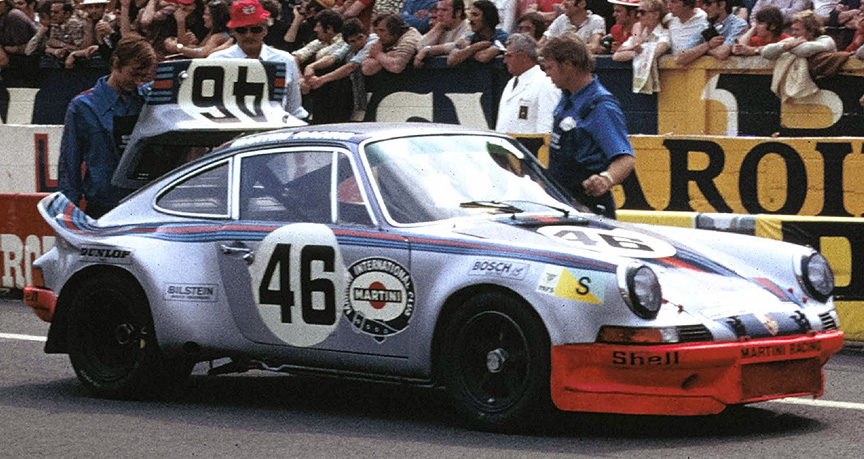
1974 Le Mans – Porsche Finished 2nd, 7th, 10th, 12th, 13th, 14th, 19th & 20th
Porsche is not in prototype racing anymore – because of marketing reasons they develop only 911-based racing cars. It is natural that they don’t have a chance against the prototypes. The heavier 911 needed more power and a turbo engine was created. The coefficient for turbo engines was 1.4, so a 2.1-litre engine was created to fit into the 3-litre class. Martini’s best drivers are again Gijs van Lennep and Herbert Müller. The 911 Carrera RSR Turbo 2.1 of Lennep/Müller and a Matra 3-litre prototype started to battle for the overall victory. Matra had ordered gearbox development from Porsche and the Porsche-designed gearbox failed on the second day. Now the #22 Porsche could have won the race, but Porsche sent its mechanics into the Matra’s garage to fix the leader’s gearbox in record time. Ironically the gearbox of the Porsche #22 also failed leaving them only with the fourth gear. The Matra wons and the 911 became second – still a remarkable result for a production based car against the racing prototypes. The Matra was driven again by Gerard Larrousse and Henri Pescarolo.
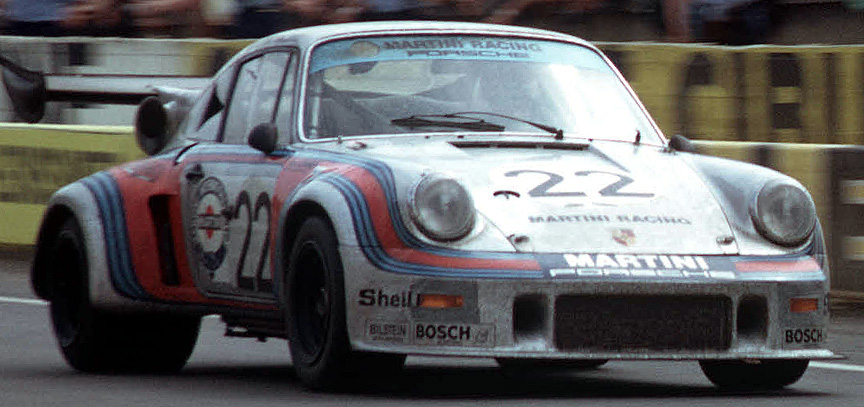
1975 Le Mans – Porsche Finished 4th, 5th, 6th, 7th, 8th, 9th, 10th, 11th, 15th, 17th, 18th, 19th, 20th, 23rd, 25th & 28th
No factory team. The best private Porsche scores 4th, a four year old 908/03 with Joest Racing modifications driven by Reinhold Jöst himself and Mario Casoni/Jürgen Barth.
1976 Le Mans – Porsche Finished 1st, 4th, 6th, 7th, 9th, 11th, 12th, 13th, 14th, 16th, 17th, 18th, 19th & 23rd
Porsche and Martini are back and the team is named for everyone to understand it is a factory team – Martini Racing Porsche System. They field a 935 and a new evolution of the 908/03 Turbo called the 936. Martini Racing Joest team fields another 936. The Martini Racing Porsche System 936 wins the event driven by Jacky Ickx/Gijs van Lennep.
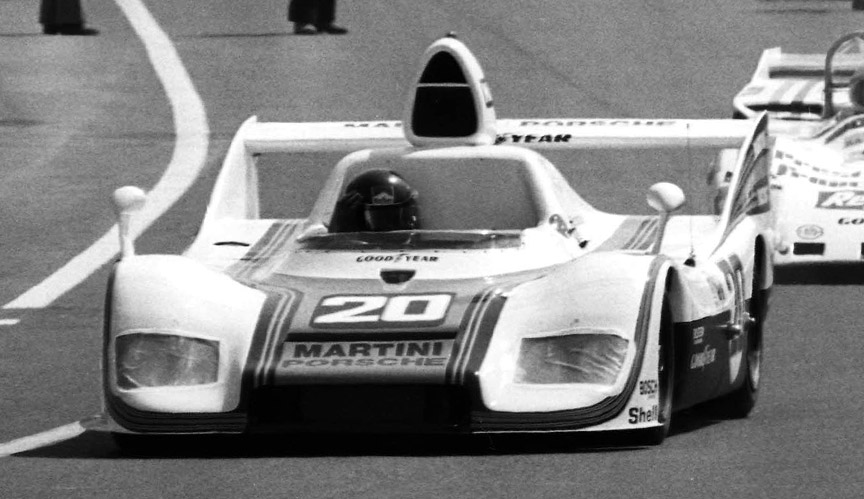
1977 Le Mans – Porsche Finished 1st, 3rd, 7th, 10th, 12th, 14th, 18th, 19th & 20th
Martini Racing Porsche System fields two 936/77 and one 935/77 among numeorus private 935s, 934s and 911s. The #3 936 of Jacky Ickx/Henri Pescarolo is 3rd in qualification, while the other 936 #4 is 7th. After the #3 loses its engine in the race, Ickx joins the drivers of the #4 car. But they were having trouble as well. They were in 42nd place. Ickx drove the whole night at top speed, always at the limit. In rain and fog. He was on the 5th place when he handed over the car. Jürgen Barth and Hurley Haywood also drove faster than ever. Their number #4 car developed engine problems on the final hour of the race. The mechanics removed the fuel injection from the damaged cylinder and the car continued on 5 cylinders and luckily managed to finish first. Third place was taken by privately entered 935 #40 of J.M.S. Racing driven by Claude Ballot-Léna/Peter Gregg.
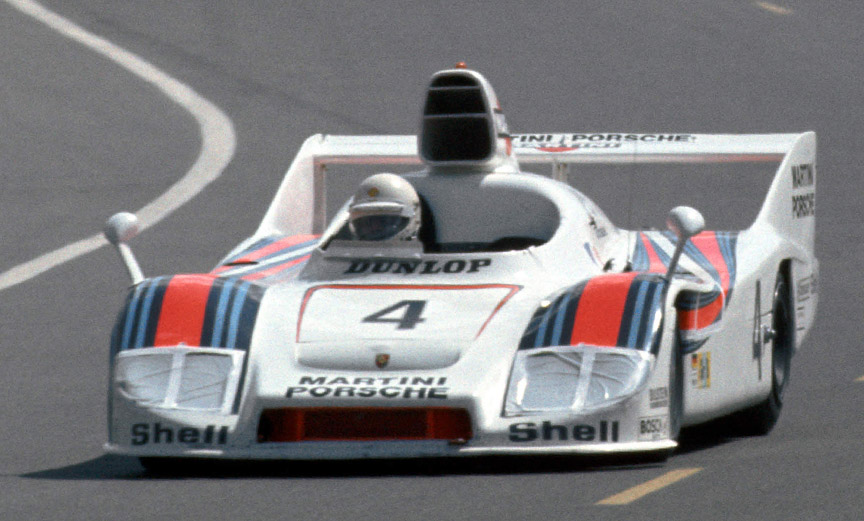
1978 Le Mans – Porsche Finished 2nd, 3rd, 5th, 6th, 7th, 8th, 12th, 14th & 17th
Martini Racing Porsche System fields two 936/78, a 936/77 and a 935/78. Like last year, many private 935s, 934s and 911s are entered aswell. The 936/78 #5 of Jacky Ickx/Henri Pescarolo/Jochen Mass that won the qualification, has to retire because of the accident. Ickx joins the #6 sister car and finishes second with Bob Wollek and Jürgen Barth. The 936/77 #7 driven by Hurley Haywood/Peter Gregg/Reinhold Jöst finished third.
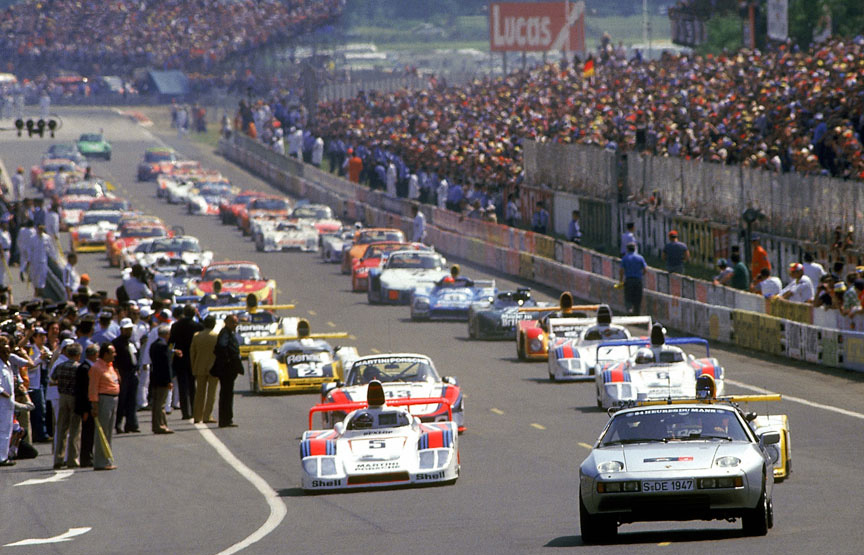
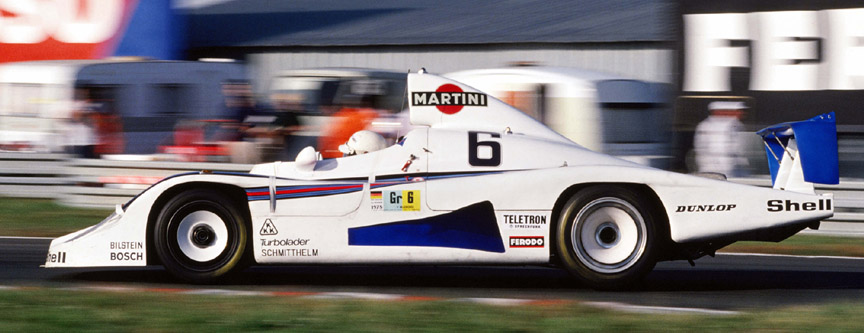
1979 Le Mans – Porsche Finished 1st, 2nd, 3rd, 4th, 7th, 8th, 9th, 11th, 13th, 15th, 16th & 19th
The construction of the new public road led to the redesign of the track. The second Dunlop Bridge was removed and the Tetre Rouge corner was opened from 90° to 50°. This increased the speed heading on to the Hunaudières straight. New track length was 13626 m (-14 m).
Fastest cars in the qualification are the two team Essex 936/78. The pace car is again the Porsche 928. Unfortunately the 936 of Bob Wollek/Hurley Haywood looses the engine in the race and the 936 of Jacky Ickx/Brian Redman was disqualified. Ickx was repairing his car after the incident when unwanted outside help was given and this led to the disqualification. Both 936s out, 935s in – the podium is taken by 935s and followed by a 934 on the 4th place. The race is won by #41 Klaus Ludwig/Bill Whittington/Don Whittington (Kremer Racing), second place goes to #70 Dick Barbour/Rolf Stommelen/Paul Newman and third to #40 François Servanin/François Trisconi/Laurent Ferrier (Kremer Racing).
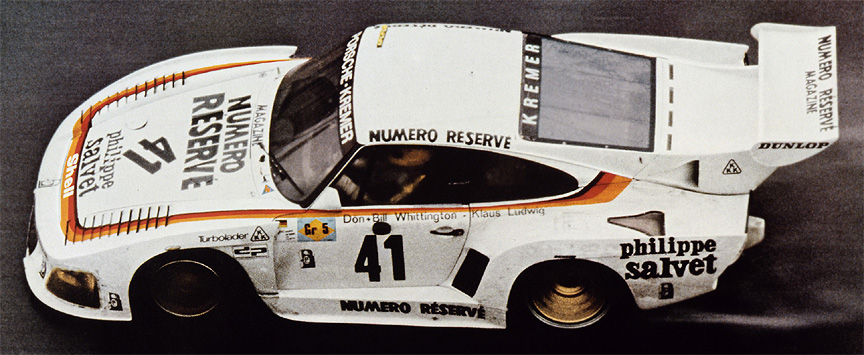

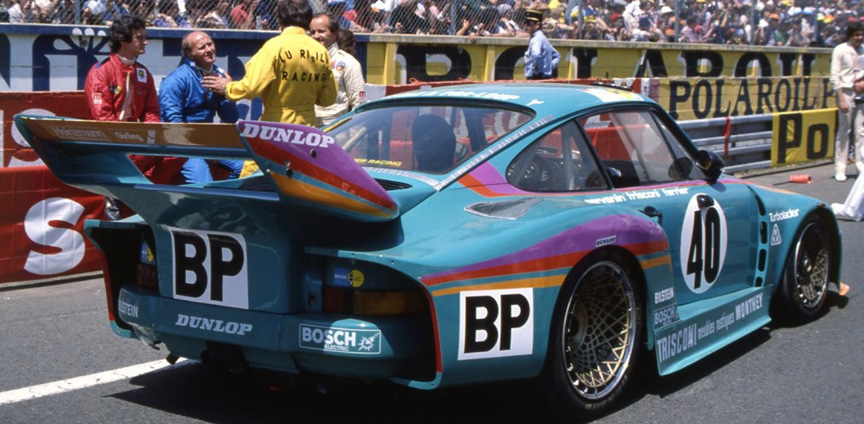
1980 Le Mans – Porsche Finished 2nd, 5th, 6th, 8th, 9th, 12th, 13th, 16th, 20th & 24th
Factory team fielded three 924 Carrera GTRs for the GTP class. The aim is not so clear as the best of them qualified on the 34th position. All the cars finished the race, which is a result on its own and the best of them managed to score 6th driven by Jürgen Barth/Manfred Schurti. The best Porsche in the race scored second – a Martini Racing 936/80 driven by Jacky Ickx/Reinhold Jöst. As it was known that the fuel injetion pump belt might broke there was the spare belt and tools in the car. Ickx did need them repairing the car beside the road. When Ickx restarted, he was not in the lead anymore and did his miracle driving until he was in the lead again at approximately 3 am. In the morning the Porsche team suffered gearbox problems. They fighted until the end, but scored second. The event was won by a Rondeau driven by Jean Rondeau /Jean-Pierre Jaussaud. It is spectacular because of two reasons – the victory was achieved by the driver with the car of his own and the car was built in Le Mans.
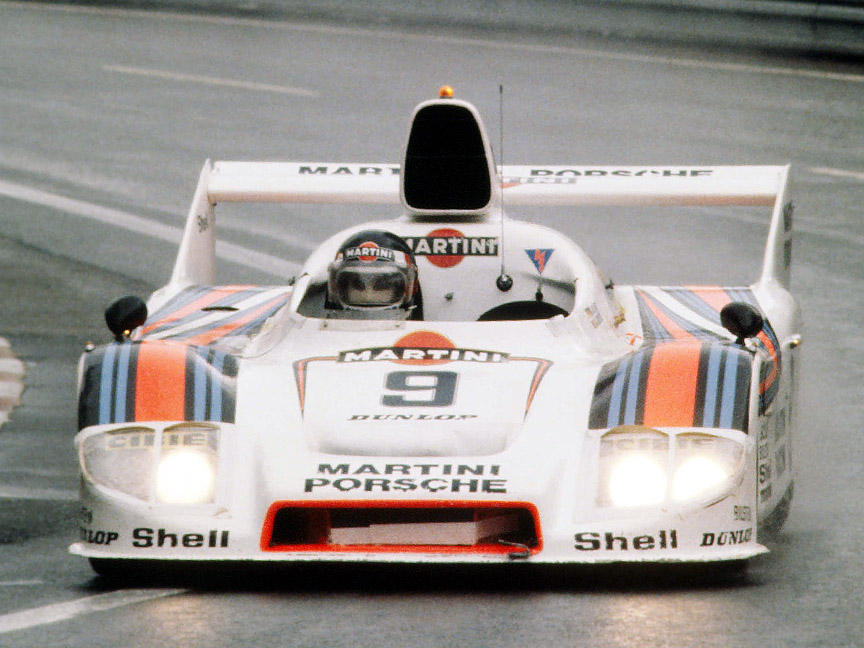
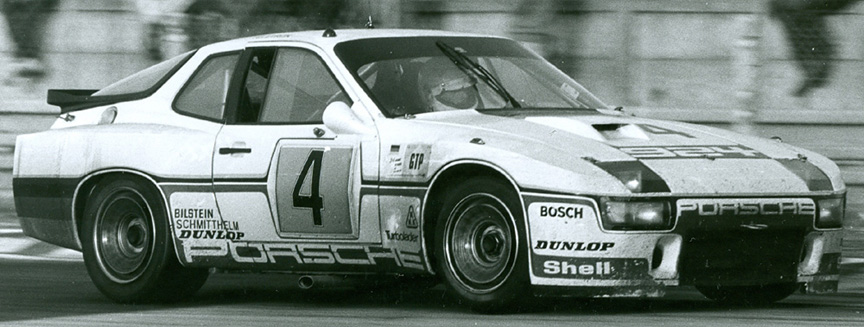
1981 Le Mans – Porsche Finished 1st, 4th, 6th, 7th, 10th, 11th, 12th, & 17th
The circuit is widened before the Esses, runoff area is expanded after the Dunlop Curve.
The factory team fielded two 936/81 and they were the quickest in the qualification. The cars had new 2.6-litre flat-6 engines with water-cooled heads. The car #11 won the race driven by Jacky Ickx/Derek Bell. This made Ickx the 5-time champion – a new record in the history of Le Mans 24 hour races. In addition, the factory team had entered a 924 Carrera GTR Turbo 2.0 and a 924 Carrera GTR Turbo 2.5. The latter was actually signed up as 924 GTP LM – Grand Tourisme Prototype Le Mans – as it raced in the GTP LM class). This car has later been mostly called as 944 Le Mans as this was written on its engine. As the 944 hadn’t debuted yet, the car was signed up as a 924. And it was a 924 Carrera GTR, just with the 2.5-litre experimental Porsche engine instead of the 2-litre VW/Audi based unit. Walter Röhrl and Jürgen Barth finished 7th overall, so it was another success for the 924 Carrera GTR.
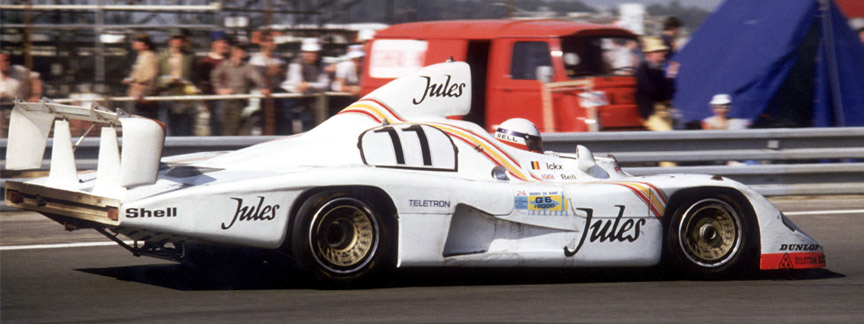
1982 Le Mans – Porsche Finished 1st, 2nd, 3rd, 4th, 5th, 8th, 11th, 13th & 16th
The factory team fielded three new 956, which… all finished on podium! More to that – the cars finished exactly as were their racing numbers. The winning car #1 was driven by Jacky Ickx/Derek Bell, the second place car #2 was driven by Jochen Mass/Vern Schuppan (3 laps behind the winner) and the last factory entered car #3 scored third driven by Al Holbert/Hurley Haywood/Jürgen Barth (19 laps from winner). The podium Porsches were followed by two 935s.
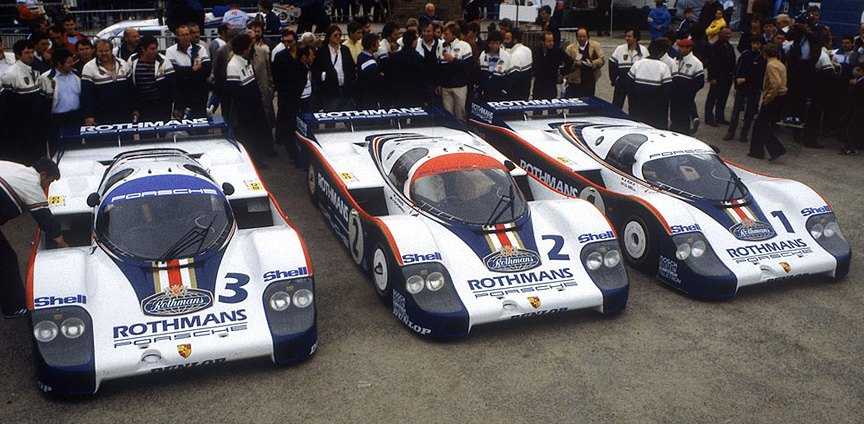
1983 Le Mans – Porsche Finished 1st, 2nd, 3rd, 4th, 5th, 6th, 7th, 8th, 10th, 11th, 13th, 15th & 20th
Like a year before, tobacco sponsored Porsche factory team entered three 956s. In addition to the factory cars private ones were entered with the total of eleven 956s. The factory team car #2 of Jochen Mass/Stefan Bellof had to retire because of engine problem while the #3 driven by Vern Schuppan/Al Holbert/Hurley Haywood won the race and #1 driven by Jacky Ickx/Derek Bell scored second. It was a close call as the engine of #3 was damaged and seized on the final lap. It did come to life for the short distance to finish the race with heavy smoke from the exhaust. The second place Porsche #1 finished at full speed only 17 seconds later. First eight places were captured by 956s and one more in position 10. The PCNA’s poster later said “Nobody’s perfect”.



1984 Le Mans – Porsche Finished 1st, 2nd, 3rd, 4th, 5th, 6th, 7th, 9th, 16th, 17th, 18th & 22nd
The factory team didn’t participate in 1984 as a protest against the change in rules just three months before the race. Fourteen 956s were entered by private racing teams and the result list was almost like the year before – first seven places went to 956s. The race was won by New-Man sponsored Joest Racing 956 #7 driven by Henri Pescarolo/Klaus Ludwig. Both men had won the race already before (now Pescarolo’s fourth victory and Ludwig’s second). 1984 was the first year the “American” version of the 956, the 962 was entered. There were two 962s, one belonging to the Swap Shop sponsored team and the other to Skoal Bandit team. Unfortunately one had to retire because of the accident and the other because of the engine. Luckily both teams had 956s, too, that would finish on podium.



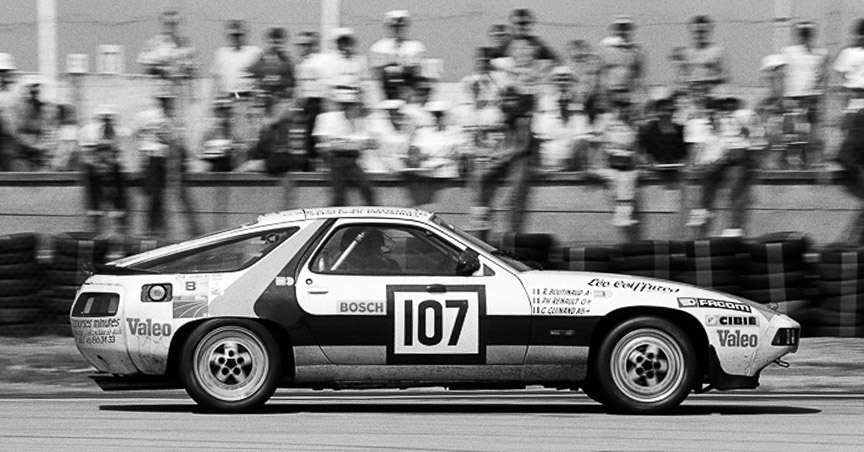
1985 Le Mans – Porsche Finished 1st, 2nd, 3rd, 4th, 5th, 8th, 9th, 10th, 20th & 22nd
For the 1985 event the tobacco sponsored factory team was back, now with three 962 Cs. The 962 C was the “European” Group C version of the 962 that was created for US customers (to comply with their IMSA rules that required safer cockpit for the driver and allowed only a single turbo). Hans-Joachim Stuck’s qualification lap of 3:14.8 averaged 156.5 mph/251.815 kmh which is the absolute record at Le Mans. The car #2 of Stuck and Derek Bell scored third as the best factory entry. The event was won again by the same team, same car and even one of the drivers as last year – the #7 956 (chassis 956-117) of New-Man sponsored Joest Racing. For 1985 Klaus Ludwig was accompanied by John Winter (Louis Krages) and Paolo Barilla. It was Klaus Ludwig’s third Le Mans victory (all achieved with Porsches). The second place was taken by Richard Lloyd team 956.
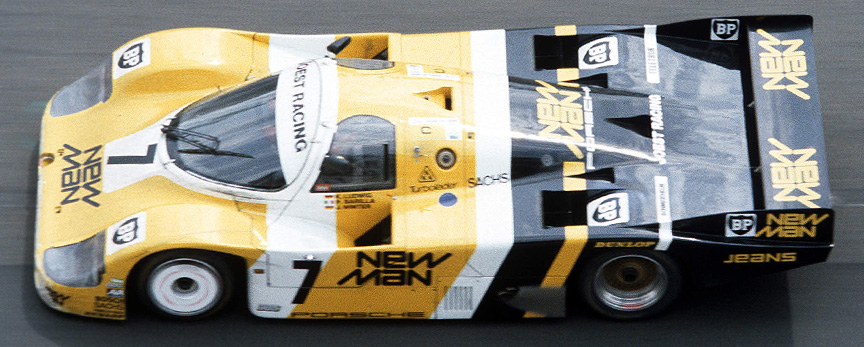


1986 Le Mans – Porsche Finished 1st, 2nd, 3rd, 4th, 5th, 6th, 7th & 10th
The Mulsanne corner at the end of the Hunaudières straight got a new layout. Because the relevant crossroad was converted to a roundabout, the organisers built a new section with a 90° corner north of the old hairpin. This 13528 m (-98 m) track version was only driven once.
The Joest Racing 956-117 is for the third time entered under the “lucky” number 7 and with the same drivers as last year. The qualification time of #7 is an excellent third result after two factory entered 962s. The best qualifiation time goes to 962 #2, but the car of Bob Wollek/Jochen Mass/Vern Schuppan retires because of an accident. 962 #1 is second in qualification, but has to win the race as the racing number suggests and Hans-Joachim Stuck/Derek Bell/Al Holbert are up to the task. The second place goes to 962 #17 of Brun Motorsport and its drivers Oscar Larrauri/Jésus Pareja/Joël Gouhier and third place to Joest Racing 956 #8 driven by George Follmer/John Morton/Kenper Miller. Driver of Kremer Racing, Jo Gartner, was killed when the gearbox of his 962 broke on Mulsanne straight and locked the rear wheels at full speed. The factory team had entered an experimental car also, the 959’s racing version called the 961. The 4WD car scores 7th driven by Claude Ballot-Léna/René Metge (Metge had won the Paris-Dakar Rally with 959 in the beginning of the year).
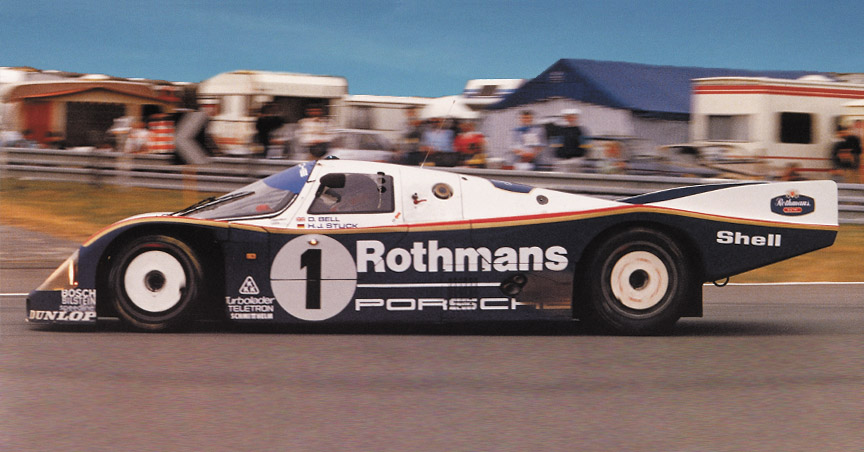
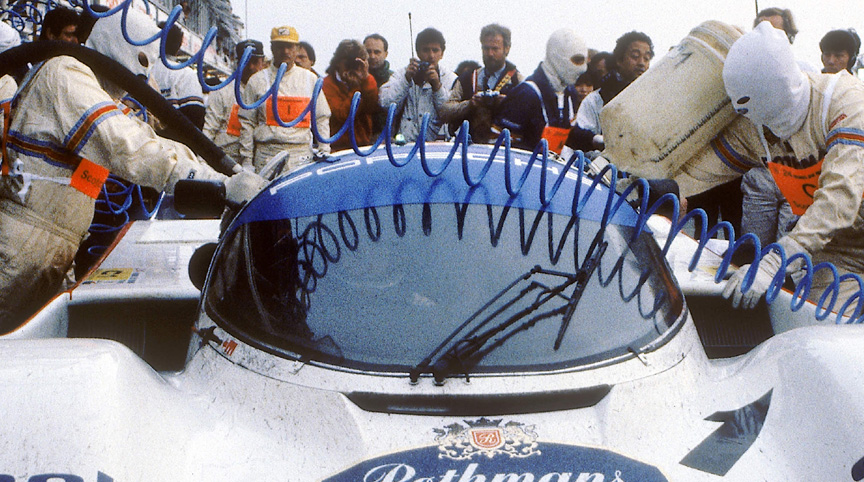
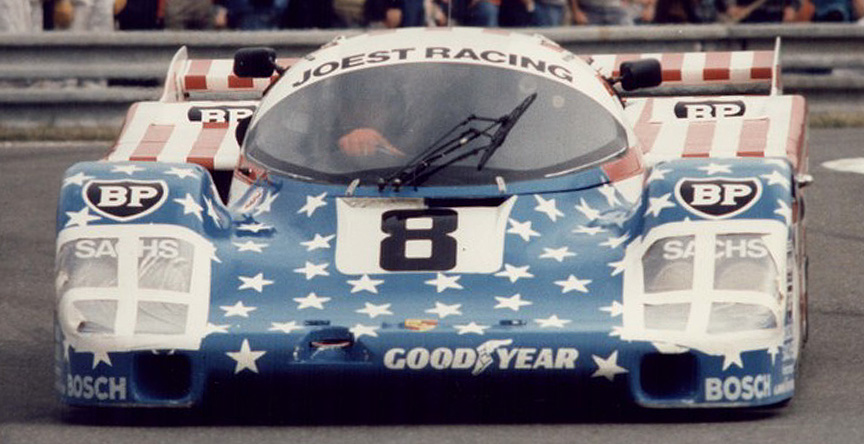
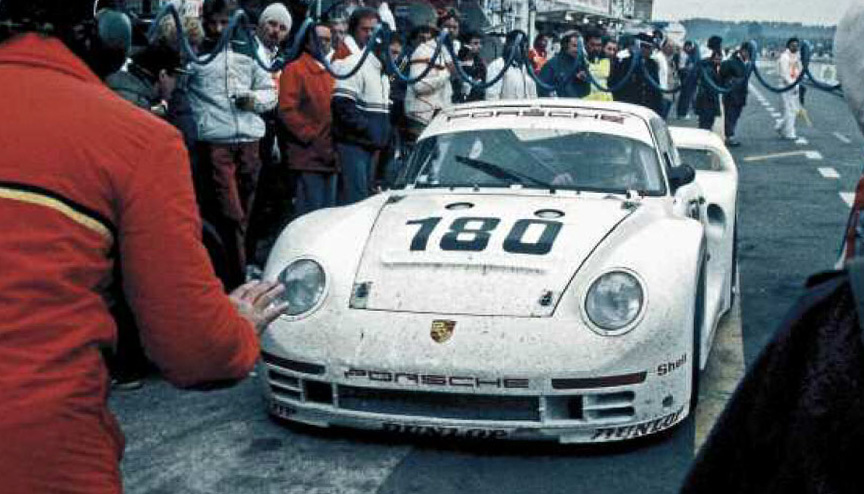
1987 Le Mans – Porsche Finished 1st, 2nd & 4th
The Dunlop corner was tamed with a left-right chicane. While cornering speeds of 250 kmh were reached earlier, they were now about 150 kmh depending on the vehicle. The new length of the track was 13535 m (+7 m).
Like last year, factory team fielded three 962s and one (and the same) 961. Factory team had built four Le Mans cars, one as a spare car, but Hans-Joachim Stuck totalled one of them at the Weissach test track, so there was no spare car for Le Mans 24H. The 962 #19 was totalled in the Le Mans practise, so there were only two factory team 962s left for the race. The #18 962 (of Jochen Mass/Bob Wollek/Vern Schuppan) that was the fastest in the qualification retires because of the engine failure in the first hour (only Mass got to drive it). So, the factory team has only one 962 left in the race and they have 23 hours to go. Still, the second fastest qualifier, 962 #17 driven by Hans-Joachim Stuck/Derek Bell/Al Holbert manages to win the race. The second place is taken by a Primagaz 962 #72 driven by Jürgen Lässig/Pierre Yver/Bernard de Dryver and third place goes to a Porsche-powered Cougar C20 (also Primagaz Compétition).
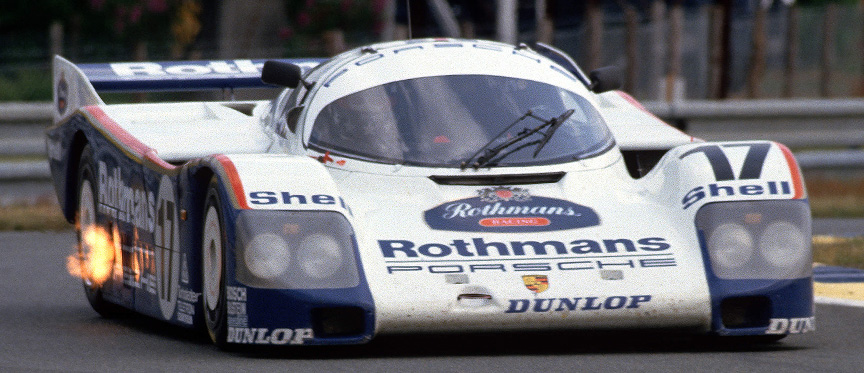

1988 Le Mans – Porsche Finished 2nd, 3rd, 5th, 6th, 7th, 8th, 9th, 10th & 11th
For 1988 the Hunaudières straight was resurfaced, increasing the top speeds. Despite the 956/962 had been on top for such a long time, Porsche was still confident on its 962. And there was the reason to be – the qualification was won by the #17 962 of the factory team. The #17 driven by Hans-Joachim Stuck/Klaus Ludwig/Derek Bell scores second because Ludwig runs out of fuel on the track and lost time getting back to the pits. The event is won by a TWR-Jaguar, despite it being 8 seconds slower per lap (qualification result vs. #17 Porsche). The third place goes to Blaupunkt-sponsored Joest Racing 962-116 #8 driven by Stanley Dickens/”John Winter”/Frank Jelinski.

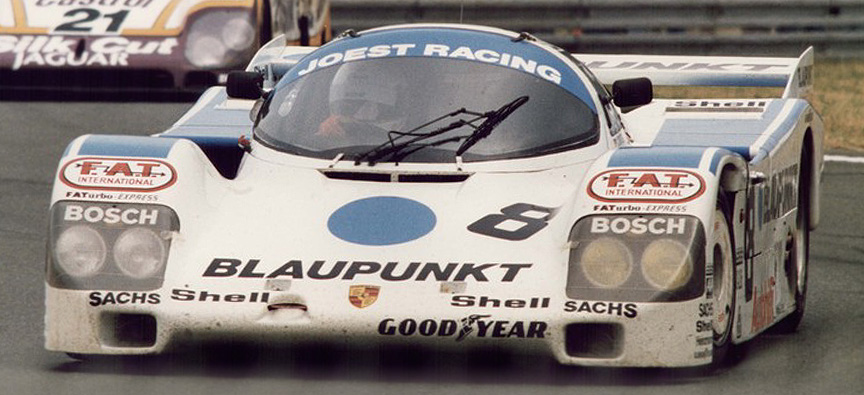
1989 Le Mans – Porsche Finished 3rd, 6th, 10th, 13th & 15th
The 962 is old and factory team is not competing anymore, but private teams field a record of seventeen 962s. Joest Racing 962 driven by Bob Wollek/Hans-Joachim Stuck manages to score third as the best Porsche.

1990 Le Mans – Porsche Finished 3rd, 4th, 8th, 9th, 10th, 11th, 12th, 13th, 14th, 15th, 16th, 19th, 24th & 26th
According to the international motorsport federation FISA, no straight must be longer than 2 km and two chicanes are made to reduce the speed on the Hunaudières straight. The new track length is 13600 m (+65 m).
Private teams field a new record of eighteen 962s and the best one is of the Alpha Racing Team and scores third driven by Tiff Needell/Anthony Reid/David Sears.
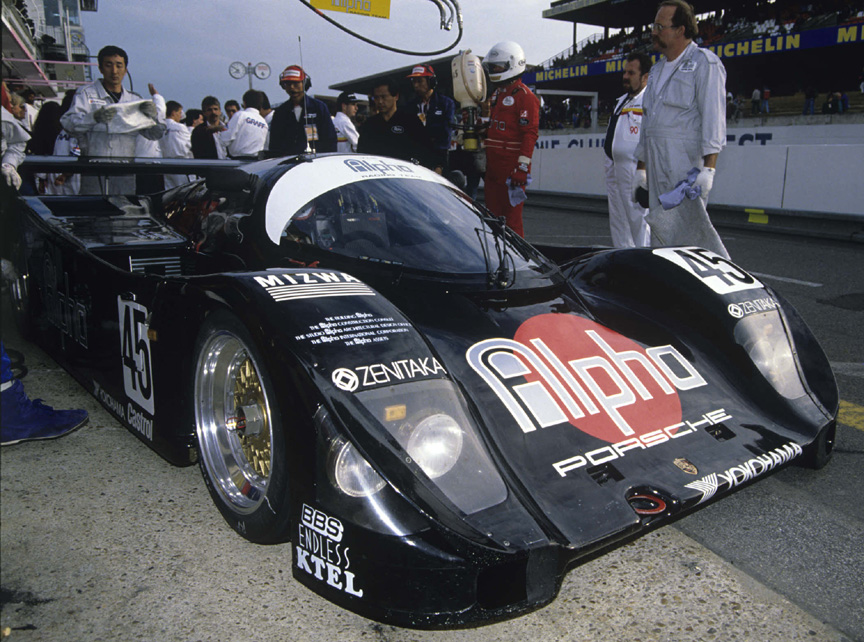
1990 Le Mans – Porsche Finished 7th, 9th & 10th
On its 10th year the Porsche 956/962 is out of competition and the best result is 7th achieved by Konrad Motorsport/Joest 962 driven by Hans-Joachim Stuck/Frank Jelinski/Derek Bell. The race is won by a Mazda with a rotary Wankel engine. It is the first time a Japanese car would win and naturally the first time a car with a non-piston engine would win.
1992 Le Mans – Porsche Finished 7th, 10th, 11th & 12th
Porsches are almost out of the scene – only five 962s start the race. It was last time 29 years ago that so few Porsches were racing at Le Mans. New number 1 for Porsche is number 7 – the Kremer Racing 962 driven by Manuel Reuter/John Nielsen/Giovanni Lavaggi achieves 7th place.
1993 Le Mans – Porsche Finished 7th, 9th, 12th, 13th, 14th, 15th, 16th, 17th, 18th, 19th, 21st, 22nd & 26th
The best result for Porsche is for the third year in a row 7th place achieved this time by Obermaier Racing 962 driven by Otto Altenbach/Jürgen Oppermann/Loris Kessel. The factory team entered one experimental car for the GT-class, a 911 964 Turbo S LM with 3.2-litre racing engine. The car was 21st in qualification, not a motivation riser. Unfortunately it had to retire in the race due to an accident. In addition to the retired Turbo S LM, many 964s (Carrera RS, Cup, RSR) were entered and the best one, the Carrera RSR #47 driven by Jürgen Barth//Dominique Dupuy/Joël Gouhier scored 15th.

1994 Le Mans – Porsche Finished 1st, 3rd, 8th, 9th, & 10th
New rules and classes were announced in good time for 1994 season. The fastest prototype class was now called the LMP1 and the fastest production car based class was called the GT1. As the production car based vehicles are considered slower than the prototypes, the GT1 cars were allowed to have larger fuel tanks and larger air restrictors than the LMP1 cars. A loophole in the rules – at least one street-legal version had to exist to participate in the GT1-class – was used and Jochen Dauer’s company built the first street-legal 962 in 1993. It was registered in Germany as Dauer 962. The following cars they worked on, were listed for the 1994 Le Mans 24H race in the GT1 classs. The result of the race was that the Dauer 962 LM #36 driven by Mauro Baldi/Yannick Dalmas/Hurley Haywood won the race and the sister car #35 driven by Hans-Joachim Stuck/Thierry Boutsen/Danny Sullivan scored third.
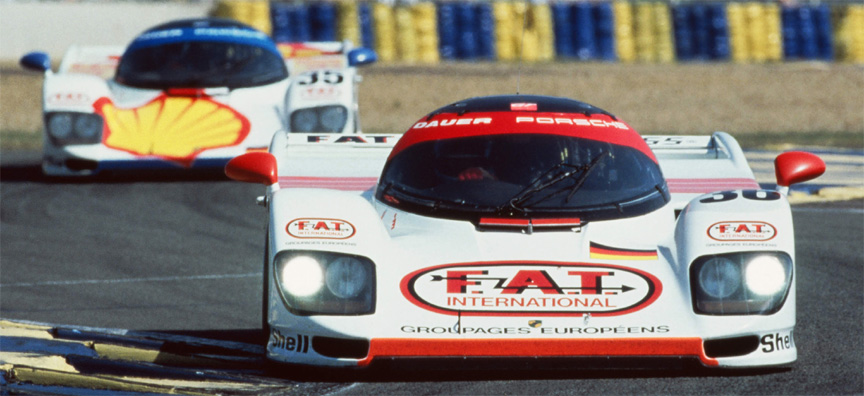

The fastest 911 in the race was a Larbre Compétition 964 Carrera RSR 3.8 #52 driven by Jésus Pareja/Dominique Dupuy/Carlos Palau – they won the GT2 class and scored 8th overall – the best result for a 964 at Le Mans.

The 1994 event saw a very rare 968 Turbo RS entered by Seikel Motorsport. Unfortunately the car didn’t finish due to an accident.

1995 Le Mans – Porsche Finished 15th, 16th, 17th & 19th
A lots of 911 993 GT2 were privately entered, but the best one only scored 15th (Peter Seikel/Guy Kuster/Karel Dolejší). The second place Courage C34 of Bob Wollek/Mario Andretti/Eric Hélar had a Porsche engine (Turbo 3.0). The event was won by a McLaren F1 GTR driven by JJ Lehto/Yannick Dalmas/Masanori Sekiya.
1996 Le Mans – Porsche Finished 2nd, 3rd, 12th, 14th, 17th, 18th, 20th & 22nd
The factory team was seriously back and fielded two 911 993 GT1 in the GT1 class. The event was won by Joest Racing LMP1-class TWR WSC95 built by Porsche with Porsche engine (Turbo 3.0). It was driven by Davy Jones/Alexander Wurz/Manuel Reuter. The two new Porsche GT1s (Turbo 3.2) came second and third: #25 driven by Bob Wollek/Thierry Boutsen/Hans-Joachim Stuck and #26 driven by Yannick Dalmas/Scott Goodyear/Karl Wendlinger.
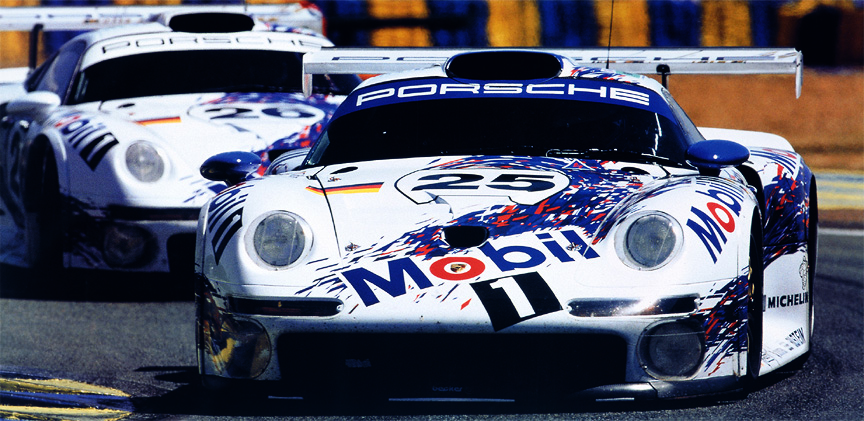
1997 Le Mans – Porsche Finished 5th, 8th, 9th, 10th, 11th & 13th
The Dunlop chicane was tightened to further reduce the speed. The famed “hump” on the Hunaudières straight was levelled out. New length of the track: 13605 m (+5 m).
The factory team entered two new 911 996 GT1. The #25 car of Bob Wollek/Hans-Joachim Stuck/Thierry Boutsen unfortunately had to retire after Wollek hit a curb and damaged the transmission and the #26 of Emmanuel Collard/Yannick Dalmas/Ralf Kelleners caught fire. The event was won again by the Joest Racing TWR WSC95 with Porsche engine (Turbo 3.0). The drivers were Michele Alboreto/Stefan Johansson/Tom Kristensen. The Joest car had the same TWR chassis that won already a year before (Joest took two consecutive wins with the same chassis also in 1984 and 1985, with the 956).
In addition to factory entered 996 GT1 cars there were five privately entered 993 GT1 and a bounch of 993 GT2s. The best result for Porsche was 5th achieved by Schübel Engineering 993 GT1 (Turbo 3.2) #33 driven by Pedro Lamy/Patrice Goueslard/Armin Hahne and the best 993 GT2 finished 9th.
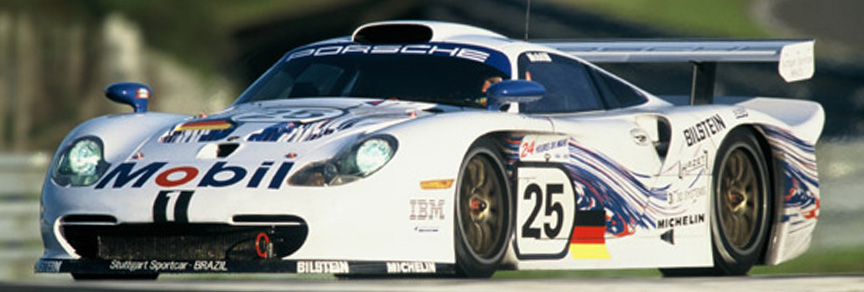
1998 Le Mans – Porsche Finished 1st, 2nd, 17th, 18th, 20th & 22nd
Joest Racing had won the Le Mans in 1996 and 1997 with its TWR WSC95 that had Porsche engine. For the 1998 Le Mans the two TWR WSC became Porsche’s factory team cars, were fitted with 3.2-litre engines and were renamed as Porsche LMP1/98. The qualification times were not very good and both of the cars retired the race – the #7 of Michele Alboreto/Stefan Johansson/Yannick Dalmas because of electrics problem and the #8 of James Weaver/Pierre-Henri Raphanel/David Murry because of the accident.
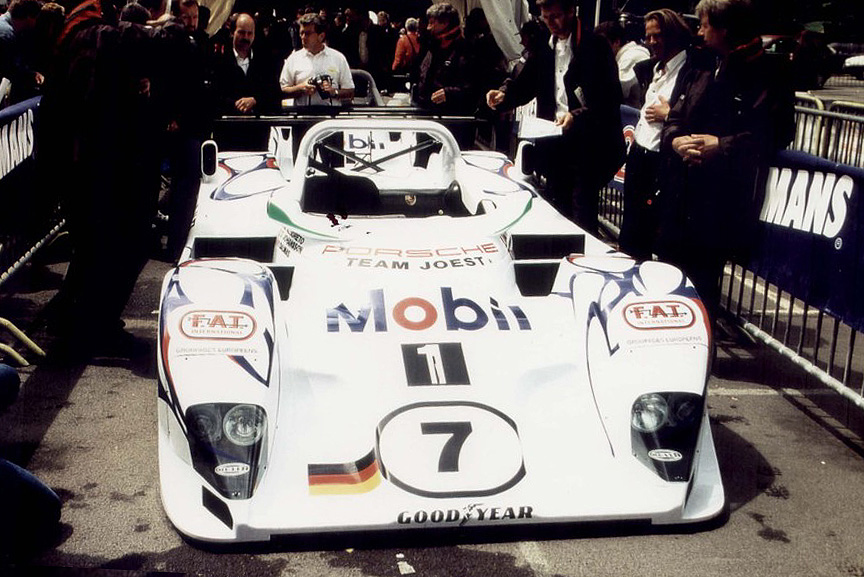
The race was dominated by GT1 cars over the LMP1 cars and the event was won by Porsche 911 996 GT1-98. This was new type 996 GT1, not the 996 GT1 used last year. The winning car #26 was driven by Allan McNish/Stéphane Ortelli/Laurent Aiello and the second place car #25 was driven by Jörg Müller/Uwe Alzen/Bob Wollek. Ferry Porsche had passed away a few months ago and the 1998 Le Mans sees the last Porsche factory entry with overall victory in mind. The new force at Porsche makes stop to racing and focuses on developing the Cayenne. The already started V10 prototype project for the Le Mans 2000 is converted into Carrera GT street car project.
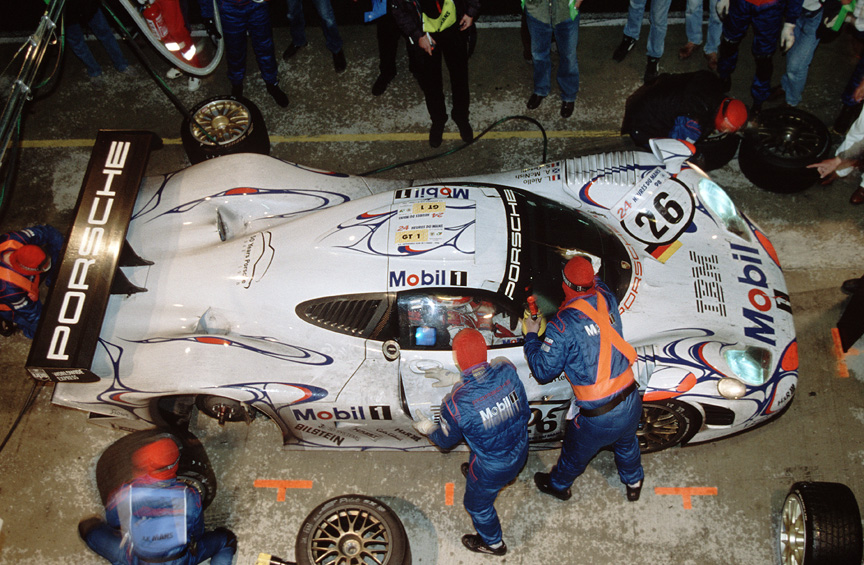

1999 Le Mans – Porsche Finished 13th, 18th, 19th, 20th & 21st
The best result for Porsche is achieved by Manthey Racing 911 996 GT3 R 3.6 #81 driven by Luca Riccitelli/Patrick Huisman/Uwe Alzen – they place 13th overall and win the GT-class. The event became famous by the flying Mercedes CLRs. The CLR driven by Mark Webber became airborne in the qualification and the car of Peter Dumbreck did the same in the race. The aerodynamic problem of building an air pillow under the nose of the car happened when the car chased other car very closely at high speed. Luckily both Webber and Dumbreck weren’t seriously hurt. Similar “take-off” had happened also to a Porsche 996 GT1 at Road Atlanta in October 1998.
2000 Le Mans – Porsche Finished 14th, 16th, 17th, 18th, 23rd, 24th & 27th
Best Porsche: Konrad Motorsport 911 993 GT2 (Turbo 3.8) #60 driven by Jürgen von Gartzen/Charles Slater/Tom Kendall – they place 14th. The Team Taisan Advan 911 996 GT3 R 3.6 #73 driven by Hideo Fukuyama/Bruno Lambert/Atsushi Yogou wins the GT-class and scores 16th overall.
2001 Le Mans – Porsche Finished 6th, 7th, 9th, 10th, 11th, 12th, 16th & 17th
Best Porsche: Seikel Motorsport 911 996 GT3 RS 3.6 #83 driven by Luca Drudi/Fabio Babini/Gabrio Rosa – they place 6th and win the GT-class. This would remain the best result for 996 GT3 at Le Mans.
2002 Le Mans – Porsche Finished 16th, 17th, 21st, 22nd & 24th
The straight between the Dunlop bridge and the Esses before the Tertre Rouge corner is converted into a fast left-right kink. The new length of the track is 13650 m (+45 m).
Best Porsche result: The Racers Group/K.Buckler 911 996 GT3 RS 3.6 #81 driven by Kevin Buckler/Timo Bernhard/Lucas Luhr scores 16th and wins the GT-class. The race is won for the third time in a row by the Joest Audi team and all three drivers were also the same in 2000, 2001 and 2002 – Tom Kristensen/Emanuele Pirro/Frank Biela. The car was also basically the same for all the years – the Dallara chassis Audi R8 (not with the same chassis numbers, though).
2003 Le Mans – Porsche Finished 14th, 17th, 18th, 19th, 20th, 23rd & 27th
Best Porsche is Alex Job Racing 911 996 GT3 RS 3.6 #93 driven by Sascha Maassen/Emmanuel Collard/Lucas Luhr. They score 14th and win the GT-class. The race is won by a Bentley and one of the drivers is again Tom Kristensen – making it his fourth win in a row!
2004 Le Mans – Porsche Finished 10th, 12th, 13th, 15th, 16th, 18th & 23rd
Best Porsche is Dale White Lightning Racing 911 996 GT3 RSR 3.6 #90 driven by Sascha Maassen/Jörg Bergmeister/Patrick Long. They score 10th and win the GT-class. The event is for the fifth time in a row won by Tom Kristensen, this time with Rinaldo Capello and Seiji Ara in a Audi R8.
2005 Le Mans – Porsche Finished 10th, 11th, 13th, 15th, 18th, 19th & 23rd
Best Porsche: is Alex Job Racing 911 996 GT3 RSR 3.6 #71 driven by Mike Rockenfeller/Marc Lieb/Leo Hindery – they score 10th and win the GT2-class. The race is won again by Tom Kristensen, this is his 7th win and 6th in a row. Jacky Ickx’s record of 6 wins was beaten. Kristensen shared the driving duties with JJ Lehto (now second time champion) and Marco Werner. The car was again an Audi R8.
2006 Le Mans – Porsche Finished 16th, 18th, 22nd & 23rd
The radius of the Dunlop corner after the finish straight was tightened and the run-off zones enlarged. The chicane after the Dunlop corner was tightened.
Best Porsche: Seikel Motorsport 911 996 GT3 RSR 3.6 #83 Lars Nielsen/Dominik Farnbacher/Pierre Ehret – they place 16th overall and 2nd in GT2-class meaning this is for a long time the first time Porsche even cannot get a class win, not to speak of overall. Tom Kristensen’s Audi is the fastest qualifier, but has some technical issues in the race which don’t allow him for better than 3rd place.
2007 Le Mans – Porsche Finished 15th & 21st
Featuring extended crash zones, additional fencing and improvements to the track surface, track work is concentrated on increased safety for competitors and spectators. The new track length is 13629 m (-21 m). Additional garages were built, allowing more teams to enter the event. As part of the new rules, the temperature inside closed-cockpit cars was now monitored and was not allowed to exceed 32°C/90°F in cars with air conditioning or 10 °C above the ambient air temperature in cars without it. The marchals would stop the cars where the allowed temperatures are exceeded. The 2007 race was started an hour earlier, at 3 pm.
Despite the 997-generation of the 911 was on the markets already from August 2004, the GT3 street version was only made by the end of 2006 as a 2007 model. The racing GT3 was available for the 2007 season. The GT2-class at Le Mans 24H is won by IMSA Performance Matmut 911 997 GT3 RSR 3.8 #76 driven by Richard Lietz/Raymond Narac/Patrick Long. They score 15th overall.
2008 Le Mans – Porsche Finished 10th, 12th, 27th & 32nd
At last some news for Porsche fans – two private teams field Porsche RS Spyders in the LMP2 class. The Van Merksteijn Motorsport #34 car driven by Peter van Merksteijn/Jos Verstappen/Jeroen Bleekemolen wins the LMP2 class and scores 10th overall while the Team Essex #31 car driven by John Nielsen/Casper Elgaard/Sascha Maassen becomes second in the LMP2 and scores 12th overall. Audi and Kristensen won again, his 8th LM24 victory now.
2008 Le Mans – Porsche Finished 10th, 12th, 27th & 32nd
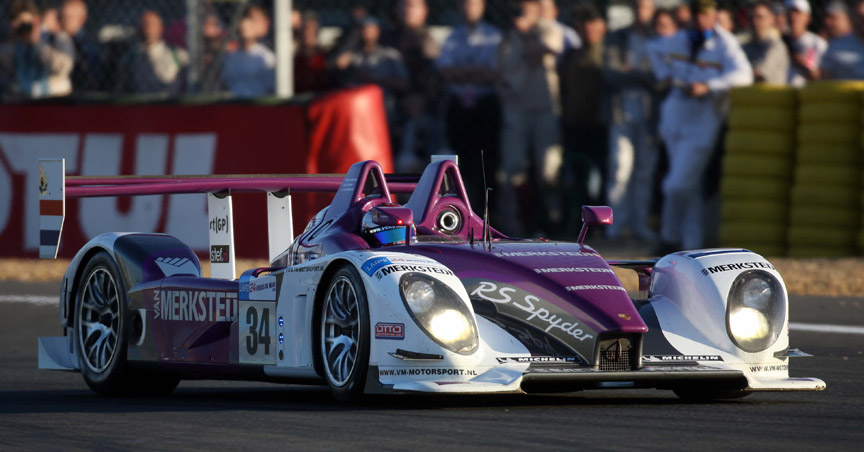
2009 Le Mans – Porsche Finished 10th
New rules allowed only one mechanic with air gun, which meant that the tyres were now replaced only when needed, not at every pit stop. Seven Porsches start the race. Only one finishes – something that has not happened since 1963. The Team Essex RS Spyder (chassis 9R6-709) #31 driven by Emmanuel Collard/Casper Elgaard/Kristian Poulsen wins the LMP2 class and scores 10th overall.
2010 Le Mans – Porsche Finished 11th, 14th, 17th 21st & 24th
Best Porsche: Team Felbermayr Proton 911 997 GT3 RSR 4.0 driven by Marc Lieb/Richard Lietz/Wolf Henzler. They win the GT2 class and score 11th overall. That would remain the best result for a 997 at Le Mans. The event is won by Audi and now Ferrari is pushed to third position in overall victory top 3. Audi is second after Porsche. 2010 is also the year when the distance record was broken that was set by Porsche in 1971. The results are not directly comparable as the Porsche record was set on the track which didn’t have chicanes on the Mulsanne straight. The 1971 distance record was 5335 km and the 2010 record was 5397 km.
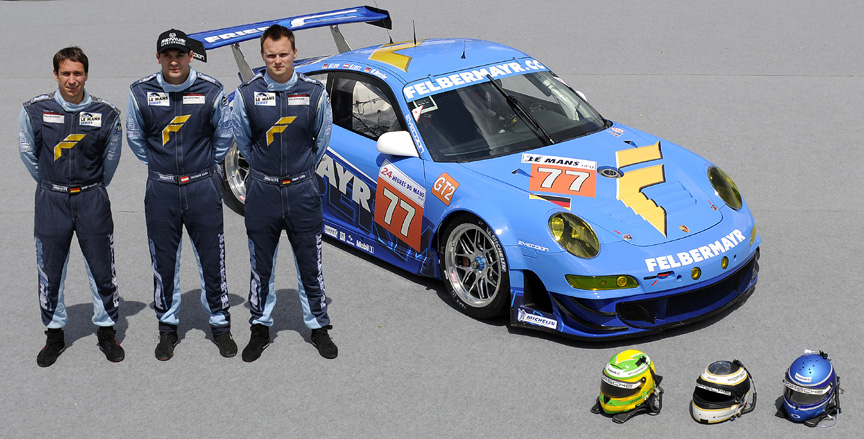
Lietz/Wolf Henzler
2011 Le Mans – Porsche Finished 16th, 17th, 18th, 21st & 23rd
New regulations stipulate LMP bodywork to have a Formula One-style vertical fin on the top of the engine cover to reduce lift tendency. In the race pace cars are needed for long periods and interestingly one of them runs out of fuel. Best Porsche is Team Felbermayr-Proton 911 997 GT3 RSR 4.0 #77 Marc Lieb/Richard Lietz/Wolf Henzler – they socred 16th.
2012 Le Mans – Porsche Finished 21st, 27th & 33rd
Best Porsche: IMSA Performance Matmut 911 997 GT3 RSR 4.0 #67 Nicolas Armindo/Raymond Narac/Anthony Pons – they finished second in the GTE Am class and scored 21st overall. The race is won by an Audi R18 e-tron quattro (electric motor on front axle).
2013 Le Mans – Porsche Finished 15th, 16th, 28th, 33rd, 35th & 36th
The race sees a lot of accidents and a record of 12 pace car periods in over 5 hours in total. Porsche factory team was back after 15 years of absence, this time with the help of Manthey Racing and the team was called Porsche AG Team Manthey. They fielded two 911 991 RSR 4.0 for the GTE Pro class and won it. The car #92 Marc Lieb/Richard Lietz/Romain Dumas came first and the car #91 Jörg Bergmeister/Patrick Pilet/Timo Bernhard came second in class. In overall standings they were 15th and 16th. The GTE Am class was won by IMSA Performance Matmut 997 GT3 RSR driven by Jean-Karl Vernay/Raymond Narac/Christophe Bourret. This marked Porsche’s 100th class victory at Le Mans. The race was won by ‘king’ Tom Kristensen for Audi. It is Kristensen’s 9th Le Mans victory. The driving was shared with Allan McNish (now three-times champion) and Loic Duval. This was Audi’s 12th overall victory and not too far from Porsche with 13+1+2 victories (13 times as Porsche, once as a Dauer and two times with Porsche engine in the TWR chassis).

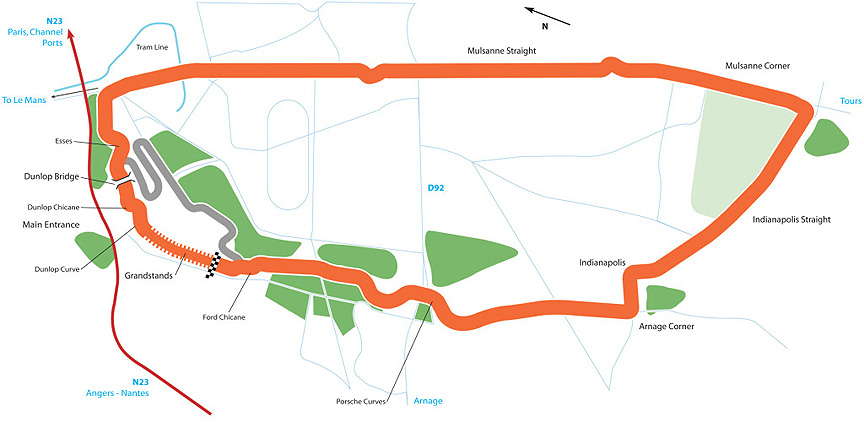
2014 Le Mans – Porsche Finished 11th, 17th, 21st, 24th, 31st, 33rd, 34th & 36th
Porsche is back in top-class racing after 16 years with the new 919 hybrid.
Half an hour into the race and the #14 Porsche 919 loses its fuel pressure. It takes 15 minutes in the pits to change the needed parts and #14 drops to 51st position. It starts to rain and at one time a traffic jam develops on the road. A reckless driver of the GT-class Ferrari 458 hits the #3 Audi R18 at the back. More cars are damaged in this accident, including a Toyota #8. Audi #3 is a write-off, while Toyota #8 limps back to garages for a new nose. Three hours into the race Toyota and Audi take their 3rd pit stops and Porsche 919 #20 takes the lead for 7 laps. An hour later, #20 again takes the lead for 9 laps when Toyota goes into pits.
Almost five hours into the race Brendon Hartley in Porsche #20 outbraked himself and went through a gap in tyres at the first chicane. Luckily, no harm done. Six hours into the race Hartley in #20 is off to gravel at Arnage, but rejoins in a minute. With almost nine hours into the race Neel Jani in Porsche #14 goes briefly off at Arnage. A factory team Porsche 911 991 RSR #91 also develops fuel pressure problems and starts to visit the box – first for 40 minutes, then for 20 minutes and then for 30 minutes. At the half race (3 am) the #14 Porsche 919 gets a new door on right side (probably a hinge or lock problem). Just a few laps later #14 is having technical problems again and is limping back to pits. It is suffering from the same problem like in the beginning of the race – low fuel pressure. It takes 15 minutes to fix the car.
In the morning at about five o’clock the leading Toyota #7 suffers from electrical problems and has to retire after otherwise problem-free race. #7 started to lead the race already seven o’clock last evening. All LMP1-H cars are having technical problems and the #7 Toyota was the strongest until it suddenly got unrepairably ill. Audi R18 e-tron #2 takes the lead. #20 Porsche is 3 laps behind. At six o’clock in the morning Marc Lieb in #14 Porsche goes off at Indy and is stuck on the gravel. He is being helped out by marchals and is moving again in a few minutes. The #20 Porsche piloted by Mark Webber is going third after two Audis. At seven in the morning the leading Audi #2 develops problems and is repaired for about 20 minutes. The #1 Audi takes the lead. Tom “Mr. Le Mans” Kristensen’s team is finally in the lead. He has 9 Le Mans victories already and is missing the 10th. Everything looks superb.
Webber in Porsche #20 is on second place. At 11 o’clock Kristensen is having problems with his car and even stops briefly at the track. He limps to pits. Timo Bernhard in the Porsche #20 takes the lead. Audi #1 returns after 17 minutes in the pits. Lotterer in #2 Audi is lapping roughly 5 seconds faster than Bernhard in #20 Porsche. At 1 pm Webber loses the internal combustion engine of his #20 Porsche. The front axle electric motor helps him to limp to pits. The race is over for #20. Audi #2 is now leading, Audi #1 going second and Toyota #8 now third – from last place after accident! Porsche #14 has problems with gearbox and comes into pits from now 4th place.
The three remaining LMP1-H cars have more than an hour to go. Nothing changes and the race is won by Audi #2, followed by Audi #1 and Toyota #8. The Porsche 919 #14 was rolled out from the garage for the final lap. With its 348 laps it is listed as 11th in the final standings list. The 919 #20 had covered 346 laps, but didn’t finish the race and is therefore not classified, although 346 laps would give 13th place.
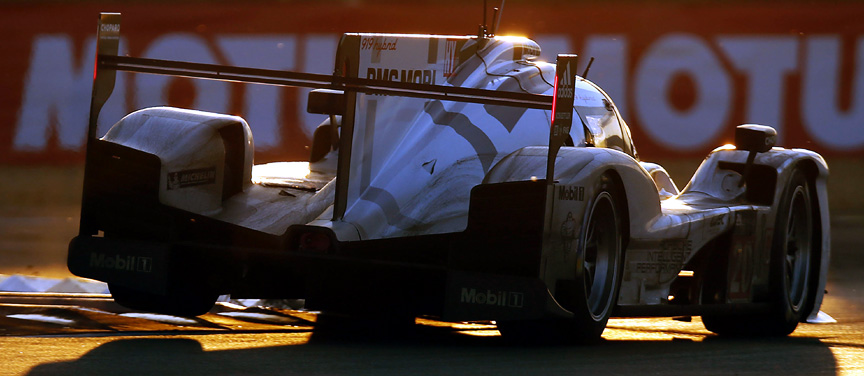
2015 Le Mans – Porsche Finished 1st, 2nd, 5th, 22nd, 30th, 35th & 37th
As a good start, Porsche LMP1 cars locked all the first three starting positions based on their qualification lap times. That happened last time 27 years earlier, in 1988. The driver of the black 919, Neel Jani, was the fastest and achieved a new lap record time 3:16.887 (previous record from 2008 was 3:18.513).
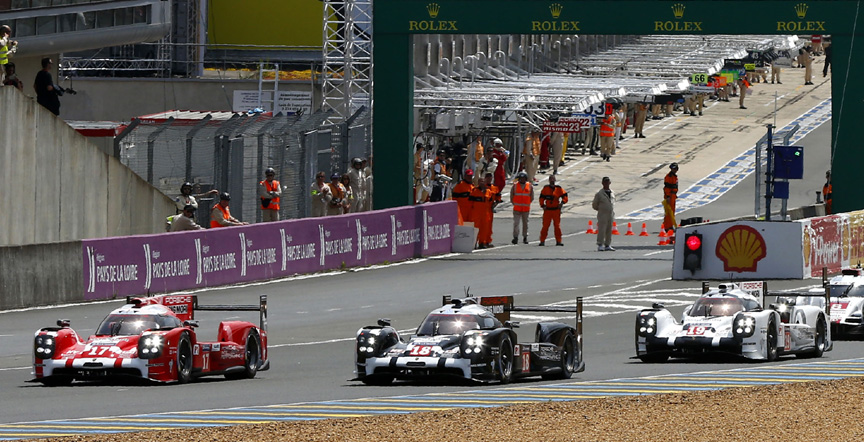
In the start, Timo Bernhard in the red 919 #17 overtook polesitter Neel Jani in the black 919 #18. Nico Hülkenberg in the white 919 #19 started third, but in two laps was passed by the three Audis. One hour into the race a complete failure happened to a factory team 991 RSR #92 which bursted into flames on the Mulsanne straight. And that was not the only 911 that mystically bursted into the flames. Although Porsche LMP1 cars were the fastest in the qualification and their pits stops were quicker, in the race Audis were a bit quicker on the track, so the lead changed constantly.
After the leading red 919 driven by Webber got a one minute Stop-and-Go penalty for earlier overtake during the yellow flags period, the white 919 went into the lead. After 9 hours, the three Porsche 919 Hybrids were in first, fourth and fifth. The first six cars were still on the same lap. For the black 919 #18 the race continued to provide some difficulties with the brake stability.
After 14 hours, the fight for the first position was still hot between Audi and Porsche. Later, Audi #7 even got drive-through penalty for passing Porsche #19 under the yellow flags. On lap 337, Andre Lotterer in Audi #7 made a race lap record of 3:17,475 (average speed 248.5 km/h). During the last three hours, no position changes happened between the three leading cars and the dream came true. The winning white 919 #19 was piloted by Nick Tandy, Earl Bamber and Nico Hülkenberg. Timo Bernhard, Mark Webber and Brendon Hartley scored second with their red 919 #17. Audi was third. The best GT-class Porsche was the Dempsey Racing 991 RSR. They scored 2nd in GTE Am class and 22nd overall. The best factory 911 scored 5th in GTE Pro class and 30th overall.
The 2015 race can be characterized as a very strong and lucky one – all the good and fast LMP1 cars (Porsche, Audi and Toyota) made it through the 24 hours without bigger problems (nor technical, nor accident-related) and even the 8th position Toyota covered only 2% less of the distance compared to the winner (386 laps vs 395 laps).
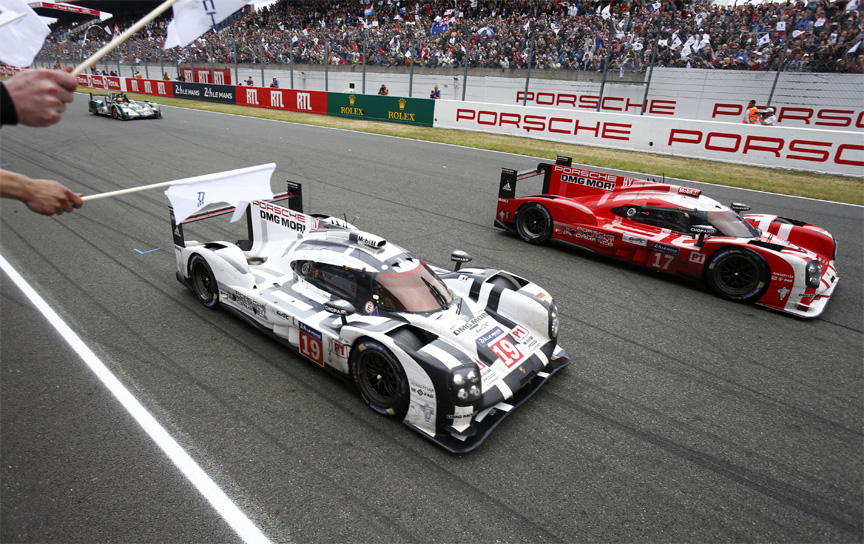
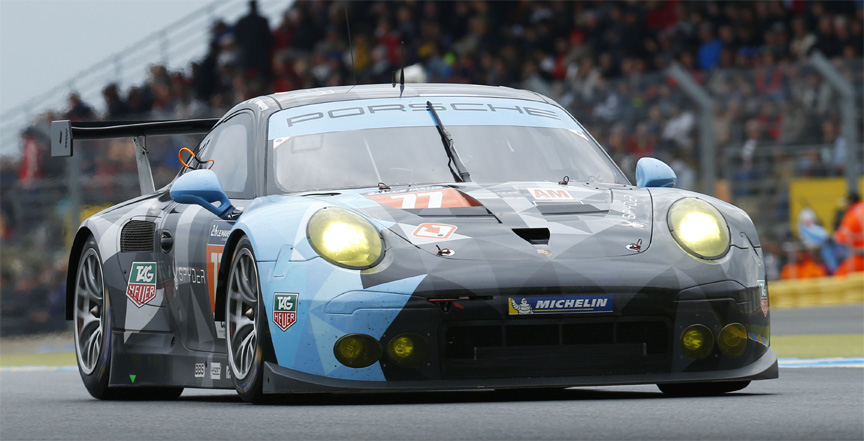
2016 Le Mans – Porsche Finished 1st, 13th, 28th, 31st, 33rd & 41st
It was the first time since 1955 that so many teams – 60 – were allowed to race. As dictated by Volkswagen, Porsche and Audi could only have 2 cars for the LMP1 class (both had 3 cars previous year). Audi #7 suffered a turbocharger failure in the start of the race. #1 Porsche managed to lead the race for over 50 laps and in the hands of Brendon Hartley achieved a top speed of 333.9 km/h (207.5 mph) which remained the speed record for Porsche in the race. Then on the 9th hour Porsche #1 generated over-heating problems.
Long repairs took it out from the race for the podium. The really strong battle was held between Porsche #2 and the two Toyotas. It seemed to everybody that Toyota will finally take the win this time. When it was just one hour to go, Toyota #5 was leading and Porsche #2 was 28 seconds behind. 6 minutes before the end of the race, the leading Toyota #5 loses power and stops on the main straight. Porsche #2 passes it to go to the final lap. Racing can get more tragic, but not more dramatic than this!
Everyone is baffled on the grand stands, in the garages of Toyota and Porsche and Neel Jani behind the wheel of the now leading Porsche 919-16 hybrid.
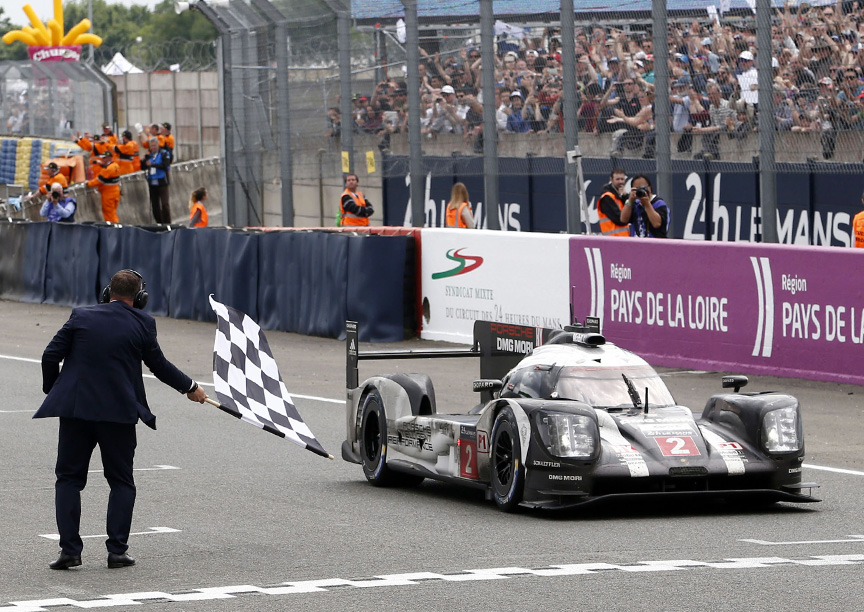
GT racing saw 911s with burning engines like in 2015. The only podium place for 911 came in the GTE Am class where Al Qubaisi/Heinemeier-Hansson/Long scored 3rd in their Abu Dhabi-Proton Racing 991 RSR #88. The engine of the #88 had burned down a year before.
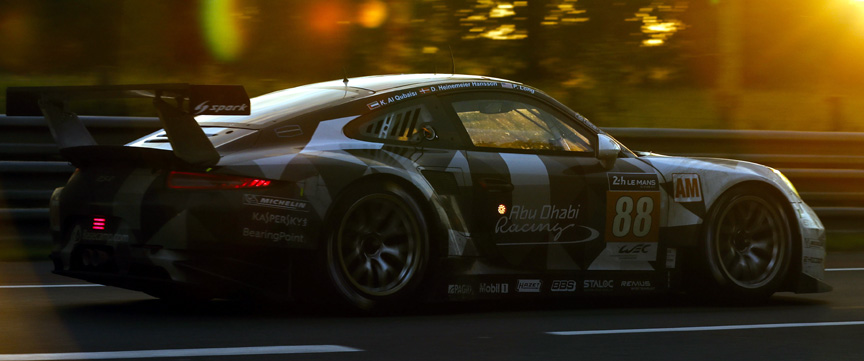
2017 Le Mans – Porsche Finished 1st, 21st, 35th, 38th & 39th
After Toyota’s 2016 Le Mans unfortunate ending and wins of the first two rounds of the 2017 FIA WEC, Toyota was determined to win the 2017 Le Mans. And many thought they deserved to win finally. To top the expectations, Toyota #7 driver Kamui Kobayashi did something amazing by breaking the fastest average lap speed in the history of Le Mans.
Interestingly, the LMP2 class cars were allowed more power for 2017, so their internal combustion engines were now more powerful than the internal combustion engines in the LMP1 cars. Although the LMP1-Hybrid cars had electric motors for out-of-the-corner acceleration, top speed was achieved with the internal combustion engines only as an electric motor cannot help at that speed. This was the first year when LMP2 cars had higher top speed than the LMP1 cars. In lap speed the LMP1 were still around 10 seconds faster and they also required less refueling stops.
3.5 hours into the race and the first of the fragile hybrid race cars was suffering problems – the Porsche #2 lost power from its electric motor. It took almost an hour to replace the MGU (motor-generator unit) and they had to start to climb up from 56th position with 19 laps down from the leading Toyota #7. Porsche #1 was fighting with the Toyota #8 for the second position.
With more than 7 hours into the race, the MGU failed also in Toyota #8. This promoted Porsche #1 to second position, between Toyota #7 and Toyota #9. At about midnight, both MGU-troubled cars “meet” on the live results list at approximately 30th position, just that Porsche #2 is moving up, but Toyota #8 is still in the garage for repairs and is dropping in the list. A second shock came to the Toyota team around quarter to one in the night – the leading Toyota #7 stopped by the road with a clutch problem. The leader was out. It is said there was a contributing factor to the clutch failure at the pit lane exit, when the car waited for the pit exit to open during the safety car period and an LMP2 driver Vincent Capillaire from the nearby pit box ran to the car in his orange suit (marshals also wear orange) giving a thumbs up to support Kobayashi and the latter understanding it was a marshal showing he should go despite the red light at the pit exit. Kobayashi quickly started off with the internal combustion engine while moving off is usually done with electric power only. The fragile clutch got harmed. Just half an hour later, the Toyota #9 – that was on the second position after leading Porsche #1 – was hit by a #25 LMP2 Oreca from behind and drove off the course. What exactly happened is not completely clear. The car was unable to get to the pits.
Everything started brilliantly for the Toyota team and ended so badly – it felt almost unfair© Eurosport
With all Toyotas out (#8 still in the race, but far-far behind), the second and third positions were taken by Oreca 07 Gibson LMP2 cars – 8 and 9 laps down from the leading Porsche #1. Over the next 10 hours Porsche is extending the lead until shocking news arrive after 11 o’clock – the leading Porsche #1 lost its internal combustion engine.
The Porsche 919 #1 had covered 318 laps and was 14 laps ahead of the second position LMP2 car. The Porsche #2 had crawled up the competitor list and was on 5th position with three LMP2 cars between the Porsches. With the retirement of the #1, the first three positions were taken by LMP2 cars with Porsche #2 chasing them. It was on the final hour of the race, that the #2 took overall lead. Earl Bamber, Timo Bernhard and Brendon Hartley won the 2017 Le Mans 24h race – from 56th position! The victory was even more happy as Porsche had won with a repaired car and not because of Toyota’s bad luck as it would have been the case when Porsche #1 would have won.
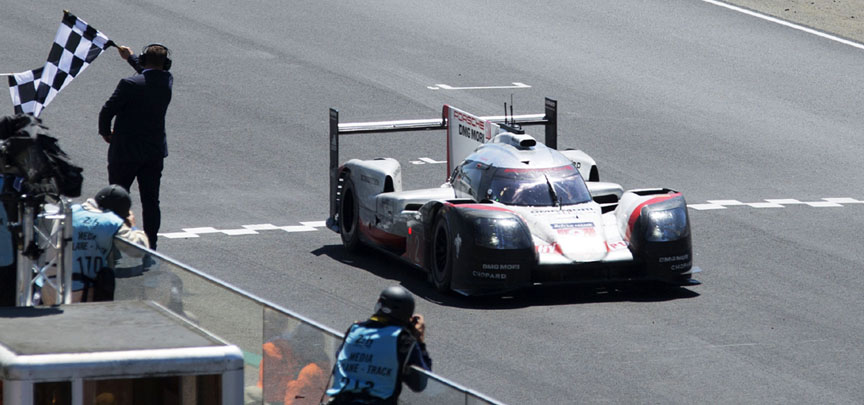
The six Porsche 911 couldn’t achieve any podium places, nor the two factory entered mid-engined 911 RSR in the GTE-Pro class, neither the four privately entered rear-engined 911 RSR in the GTE-Am class.
2018 Le Mans – Porsche Finished 17th, 18th, 28th, 30th, 32nd, 34th, 37th & 43rd
Although Porsche planned to race in the LMP1 category until 2018 when the 919 Hybrid was launched in 2014, after 3 consecutive wins it was a good idea to leave LMP1 as a winner. Leaving LMP1 meant Porsche factory team focused on the GTE Pro category and entered it with 4 mid-engined 911 RSRs! Six more 911 RSR were entered by private teams.
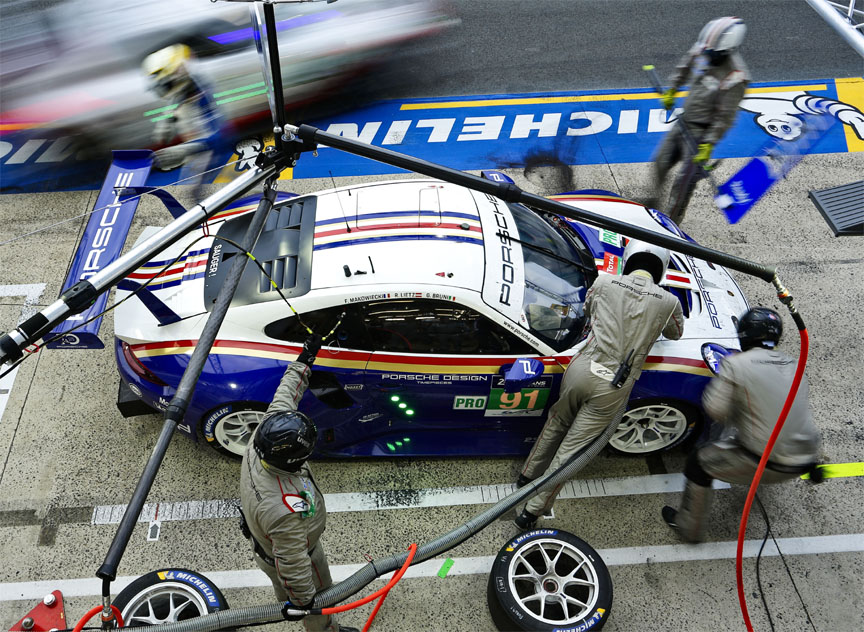

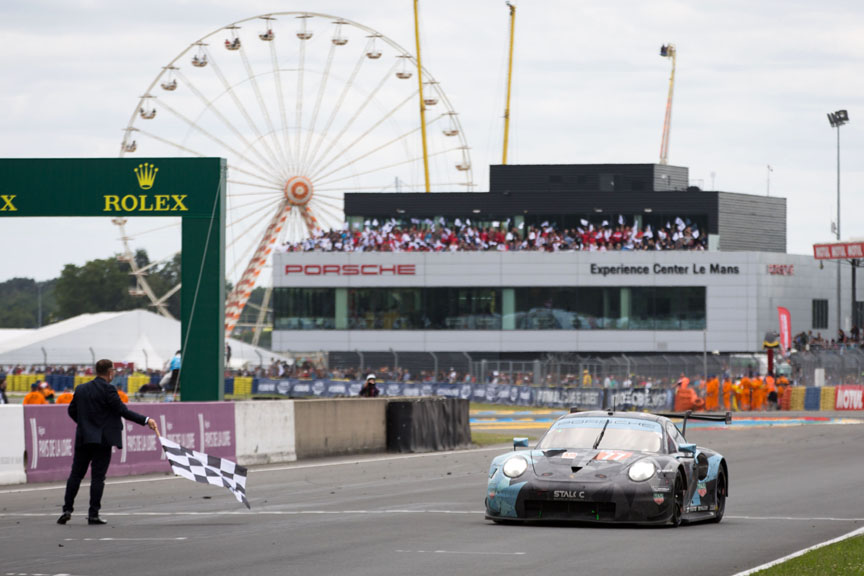
2019 Le Mans – Porsche Finished 21st, 22nd, 27th, 29th, 31st, 34th, 36th & 38th
While the factory 911 RSRs scored 2nd and 3rd in the GTE Pro category, something remarkable happened in the GTE Am category. The GTE Am winning Ford GT was disqualified as its fuel tank could carry 0.1 litres more fuel than allowed. The second place Porsche 911 RSR #56 of Bergmeister/Lindsey/Perfetti became the 2019 Le Mans GTE Am class winner.
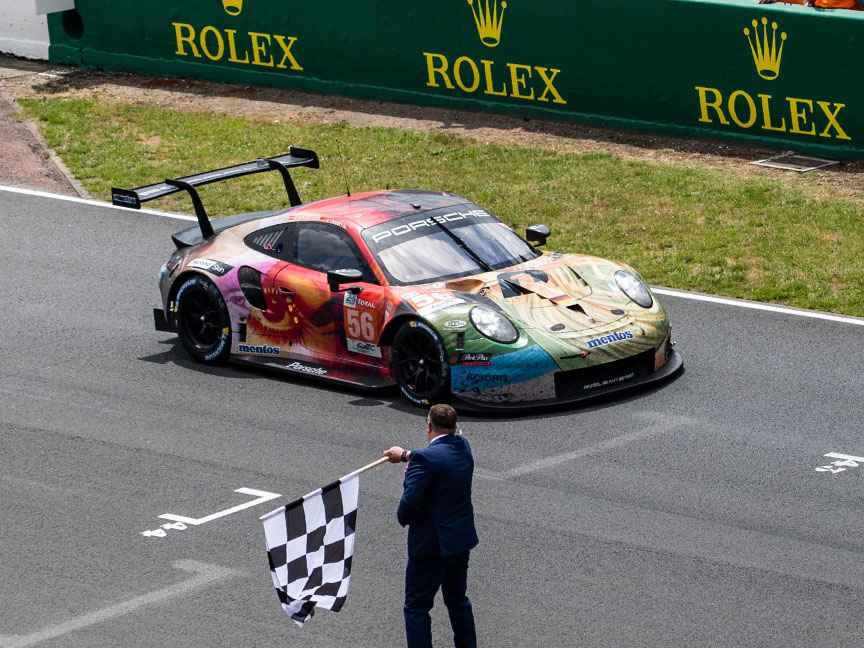
Porsche at Le Mans 1951-2019 quick overview
The following table is a visualization that shows Porsches among all the participants of Le Mans 24 hour race from 1951 to 2018. Green cells show cars that were classified and red cells show cars that were not classified or retired (technical problem, accident, not enough laps). The gray cells show the cars that were classified at the 1955 disastrous event – these results are not meaningful as some teams quit the race halfway to honour the dead. Porsches are marked with black text. The table has a lot of rows, so it is shrinked together and is hard to read, but the most important information – the eras when Porsche was king or was not, can be seen by the distribution of finish places. Between 1951-2019, 814 Porsches have competed in Le Mans.
Porsche at Le Mans 1951-2019
Porsches at Le Mans 24h 1951-2019: green shows classified cars, red shows not classified cars, Porsches are written with black text (964, 993, 997 and 991 are the types of 911, RSS – RS Spyder, P1 – Porsche LMP1/98 with TWR chassis, PE – Porsche engine in other chassis)





